An Overview of Bioplastic Research on Its Relation to National Policies
Abstract
1. Introduction
- Biobased or partly biobased, nonbiodegradable plastics such as biobased polyethylene (PE), polypropylene (PP), poly (vinyl siloxane) (PVS), or poly (ethylene terephthalate) (PET)—so-called drop-ins—and biobased technical performance polymers such as poly (trimethylene terephthalate) (PTT) or thermoplastic polyester elastomers (TPC-ET).
- Plastics that are both biobased and biodegradable, such as poly (lactic acid) (PLA) and polyhydroxyalkanoates (PHA) or starch polymers.
- Plastics that are based on fossil resources and are biodegradable, such as poly (butylene adipate terephthalate) (PBAT), poly (butylene succinate) (PBS), or polycaprolactone (PCL).
2. Methodology and Data Sources
3. National Policies on Bioplastics and Bioeconomy
3.1. China
3.2. United States
3.3. Germany
3.4. Japan
3.5. Spain
3.6. India
- To launch four major missions in healthcare, food and nutrition, clean energy, and education.
- To create a technology development and translation network across India with global partnership, including 5 new clusters, 40 biotech incubators, 150 Technology Transfer Offices (TTOs), and 20 bioconnect centers.
- To ensure strategic and focused investment in building the human capital by setting up a Life Sciences and Biotechnology Education Council.
3.7. Malaysia
3.8. Italy
3.9. Indonesia
3.10. Thailand
3.11. Canada
4. Results
4.1. Global Bibliometric Analysis
4.2. Keywords Analysis
5. Discussion
6. Conclusions
Author Contributions
Funding
Institutional Review Board Statement
Informed Consent Statement
Data Availability Statement
Acknowledgments
Conflicts of Interest
References
- Thompson, R.C.; Moore, C.J.; vom Saal, F.S.; Swan, S.H. Plastics, the environment and human health: Current consensus and future trends. Philos. Trans. R. Soc. B Biol. Sci. 2009, 364, 2153–2166. [Google Scholar] [CrossRef]
- Pei, L.; Schmidt, M.; Wei, W. Conversion of Biomass into Bioplastics and Their Potential Environmental Impacts. Biotechnol. Biopolym. 2011. [Google Scholar] [CrossRef]
- European Bioplastics, What Are Bioplastics? Material Types, Terminology, and Labels—An Introduction. 2018. Available online: https://docs.european-bioplastics.org/publications/fs/EuBP_FS_What_are_bioplastics.pdf (accessed on 1 June 2021).
- Laycock, B.; Halley, P.; Pratt, S.; Werker, A.; Lant, P. The chemomechanical properties of microbial polyhydroxyalkanoates. Prog. Polym. Sci. 2014, 39, 397–442. [Google Scholar] [CrossRef]
- Meereboer, K.W.; Misra, M.; Mohanty, A.K. Review of recent advances in the biodegradability of polyhydroxyalkanoate (PHA) bioplastics and their composites. Green Chem. 2020, 22. [Google Scholar] [CrossRef]
- Gumel, A.M.; Annuar, M.S.M.; Heidelberg, T.; Gumel, A.M.; Annuar, M.S.M.; Heidelberg, T. Biosynthesis and Characterization of Polyhydroxyalkanoates Copolymers Produced by Pseudomonas putida Bet001 Isolated from Palm Oil Mill Effluent. PLoS ONE 2012, 7, e45214. [Google Scholar] [CrossRef]
- Araújo, T.R.; Petkowicz, C.L.D.O.; Cardoso, V.L.; Filho, U.C.; Vieira, P.A. Biopolymer production using fungus Mucor racemosus Fresenius and glycerol as substrate. Polímeros 2016, 26, 144–151. [Google Scholar] [CrossRef]
- Kaparapu, J. Polyhydroxyalkanoate (PHA) Production by Genetically Engineered Microalgae: A Review Jyothi Kaparapu. J. New Biol. Rep. 2020, 7, 68–73. [Google Scholar]
- Mohapatra, S.; Maity, S.; Dash, H.R.; Das, S.; Pattnaik, S.; Rath, C.C.; Samantaray, D. Bacillus and biopolymer: Prospects and challenges. Biochem. Biophys. Rep. 2017, 12, 206–213. [Google Scholar] [CrossRef]
- Sav, A.R.; Mittal, A.K.; Thorat, A.A.; Dubey, S.; Banerjee, U.C. A Comparative study on the production of PHA by three different Pseudomonas sp. Int. J. Curr. Microbiol. Appl. Sci. 2014, 3, 940–954. [Google Scholar]
- Ojha, N.; Das, N. Optimization and Characterization of Polyhydroxyalkanoates and its Copolymers Synthesized by Isolated Yeasts. Res. J. Pharm. Technol. 2017, 10, 861. [Google Scholar] [CrossRef]
- Johnsson, N.; Steuer, F. Bioplastic Material from Microalgae: Extraction of Starch and PHA from Microalgae to Create a Bioplastic Material. 2018. Available online: http://www.diva-portal.org/smash/record.jsf?pid=diva2%3A1228894&dswid=-2569 (accessed on 1 June 2021).
- Jem, K.J.; Tan, B. The development and challenges of poly (lactic acid) and poly (glycolic acid). Adv. Ind. Eng. Polym. Res. 2020, 3, 60–70. [Google Scholar] [CrossRef]
- Henton, D.; Gruber, P.; Lunt, J.; Randall, J. Polylactic Acid Technology. Nat. Fibers Biopolym. Biocompos. 2005, 16, 527–577. [Google Scholar] [CrossRef]
- Tang, X.; Alavi, S.; Herald, T.J. Effects of plasticizers on the structure and properties of starch–clay nanocomposite films. Carbohydr. Polym. 2008, 74, 552–558. [Google Scholar] [CrossRef]
- Teixeira, E.D.M.; Curvelo, A.A.; Corrêa, A.C.; Marconcini, J.M.; Glenn, G.M.; Mattoso, L.H. Properties of thermoplastic starch from cassava bagasse and cassava starch and their blends with poly (lactic acid). Ind. Crops Prod. 2012, 37, 61–68. [Google Scholar] [CrossRef]
- Schwach, E.; Avérous, L. Starch-based biodegradable blends: Morphology and interface properties. Polym. Int. 2004, 53, 2115–2124. [Google Scholar] [CrossRef]
- Priya, B.; Gupta, V.K.; Pathania, D.; Singha, A.S. Synthesis, characterization and antibacterial activity of biodegradable starch/PVA composite films reinforced with cellulosic fibre. Carbohydr. Polym. 2014, 109, 171–179. [Google Scholar] [CrossRef] [PubMed]
- Soares, F.C.; Yamashita, F.; Müller, C.; Pires, A.T. Effect of cooling and coating on thermoplastic starch/poly(lactic acid) blend sheets. Polym. Test. 2014, 33, 34–39. [Google Scholar] [CrossRef]
- Bendaoud, A.; Chalamet, Y.; Bendaoud, A.; Chalamet, Y. Effects of relative humidity and ionic liquids on the water content and glass transition of plasticized starch. Carbohydr. Polym. 2013, 97, 665–675. [Google Scholar] [CrossRef]
- Lu, D.R.; Xiao, C.M.; Xu, S.J. Starch-based completely biodegradable polymer materials. Express Polym. Lett. 2009, 3, 366–375. [Google Scholar] [CrossRef]
- Kabir, E.; Kaur, R.; Lee, J.; Kim, K.-H.; Kwon, E.E. Prospects of biopolymer technology as an alternative option for non-degradable plastics and sustainable management of plastic wastes. J. Clean. Prod. 2020, 258, 120536. [Google Scholar] [CrossRef]
- Andrady, A.L.; Neal, M.A. Applications and societal benefits of plastics. Philos. Trans. R. Soc. B Biol. Sci. 2009, 364, 1977–1984. [Google Scholar] [CrossRef]
- European Bioplastics, Bioplastics Definition, Bioplastics. (n.d.) Available online: https://www.european-bioplastics.org/bioplastics/ (accessed on 1 June 2021).
- European Bioplastics, Bioplastic Market Data 2019. Available online: https://docs.european-bioplastics.org/publications/market_data/Report_Bioplastics_Market_Data_2019.pdf (accessed on 1 June 2021).
- Vinet, L.; Zhedanov, A. A ‘missing’ family of classical orthogonal polynomials. J. Phys. A Math. Theor. 2011, 44. [Google Scholar] [CrossRef]
- Philp, J. OECD Policies for Bioplastics in the Context of a Bioeconomy, 2013. Ind. Biotechnol. 2014, 10, 19–21. [Google Scholar] [CrossRef]
- Jaworski, J. The Application of Biotecnology to Industrial Sustainability—A Primer. 2001. Available online: www.oecd.org/sti/biotechnology (accessed on 1 June 2021).
- OECD. The Bioeconomy to 2030: Designing a Polity Agenda; OECD: Paris, France, 2009. [Google Scholar]
- OECD. Towards Green Growth; OECD Publ.: Paris, France, 2020; p. 144. [Google Scholar] [CrossRef]
- European Commission. Bioplastics: Sustainable materials for building a strong and circular European bioeconomy. Res. Results Pack. 2017, 1–20. [Google Scholar] [CrossRef]
- Sataloff, R.T.; Johns, M.M.; Kost, K.M. A Strategy for Smart, Sustainable and Inclusive Growth 2010. Available online: http://eur-lex.europa.eu/LexUriServ/LexUriServ.do?uri=COM:2010:2020:FIN:EN:PDF (accessed on 1 June 2021).
- Sataloff, R.T.; Johns, M.M.; Kost, K.M. The CAP towards 2020: Meeting the Food, Natural Resources and Territorial Challenges of the Future 2010. Available online: https://eur-lex.europa.eu/LexUriServ/LexUriServ.do?uri=COM:2010:0672:FIN:en:PDF (accessed on 1 June 2021).
- European Commission. European Commission: Roadmap to a Resource Efficient Europe. 2011. Available online: https://www.europarl.europa.eu/meetdocs/2009_2014/documents/com/com_com(2011)0571_/com_com(2011)0571_en.pdf (accessed on 1 June 2021).
- Karan, H.; Funk, C.; Grabert, M.; Oey, M.; Hankamer, B.; Karan, H.; Funk, C.; Grabert, M.; Oey, M.; Hankamer, B. Green Bioplastics as Part of a Circular Bioeconomy. Trends Plant Sci. 2019, 24, 237–249. [Google Scholar] [CrossRef] [PubMed]
- Mutha, N.H.; Patel, M.; Premnath, V. Plastics materials flow analysis for India. Resour. Conserv. Recycl. 2006, 47, 222–244. [Google Scholar] [CrossRef]
- Wuni, I.Y.; Shen, Q.; Osei-Kyei, R. Scientometric review of global research trends on green buildings in construction journals from 1992 to 2018. Energy Build. 2019, 190, 69–85. [Google Scholar] [CrossRef]
- Cabeza, L.F.; Chàfer, M.; Mata, É. Comparative Analysis of Web of Science and Scopus on the Energy Efficiency and Climate Impact of Buildings. Energies 2020, 13, 409. [Google Scholar] [CrossRef]
- Van Eck, N.J.; Waltman, L. Software survey: VOSviewer, a computer program for bibliometric mapping. Science 2009, 84, 523–538. [Google Scholar] [CrossRef]
- World Population Prospects—Population Division—United Nations. Available online: https://population.un.org/wpp/Download/Standard/Population/ (accessed on 24 February 2021).
- UNESCO. Perspectives on Emerging Issues 2015. Available online: https://en.unesco.org/sites/default/files/usr15_perspectives_on_emerging_issues.pdf (accessed on 1 June 2021).
- Beijing, A.E. Wissenschaft und Technologie in China; 2016. [Google Scholar]
- Mol, A.; Liu, Y. Institutionalising cleaner production in China: The Cleaner Production Promotion Law. Int. J. Environ. Sustain. Dev. 2005, 4, 227. [Google Scholar] [CrossRef]
- Mol, A.P.J.; He, G.; Zhang, L. Information Disclosure in Environmental Risk Management: Developments in China. J. Curr. Chin. Aff. 2011, 40, 163–192. [Google Scholar] [CrossRef]
- Swaine, M.D. The 19th Party Congress and Chinese Foreign Policy. Available online: www.china.org.cn/english/features/49007.html (accessed on 1 June 2021).
- Fund, C.; El-Chichakli, B.; Patermann, C.; Dieckhoff, P. Bioeconomy Policy (Part II): Synopsis of National Strategies around the World 2015. Available online: https://biooekonomierat.de/fileadmin/international/Bioeconomy-Policy_Part-II.pdf (accessed on 1 June 2021).
- Cao, C.; Suttmeier, R.P.; Simon, D.F. China’s 15-year science and technology plan. Phys. Today 2006, 59, 38–43. [Google Scholar] [CrossRef]
- USDA. USDA Biopreferred. 2020. Available online: https://biopreferred.gov/BioPreferred/ (accessed on 1 June 2021).
- Shina, R. The National Bioeconomy Blueprint: Meeting Grand Challenges. Ind. Biotechnol. 2012, 8, 94–96. [Google Scholar] [CrossRef]
- Hüttl, R.F. Bio-economy Innovation. Bio-economy Council Report 2010. Available online: https://biooekonomierat.de/fileadmin/Publikationen/Englisch/bioeconomy_council_report_2010.pdf (accessed on 1 June 2021).
- Hüttl, R.F. Internationalisation of Bio-Economy Research in Germany 2012. Available online: https://biooekonomierat.de/fileadmin/Publikationen/Englisch/BOER_Recommendation05_internationalization.pdf (accessed on 1 June 2021).
- Federal Ministry of Education and Research (BMBF). National Research Strategy BioEconomy 2030 Our Route towards a Biobased Economy. 2011. Available online: www.bmbf.de/pub/bioeconomy_2030.pdf (accessed on 1 June 2021).
- Taniguchi, R. Resource Mobilization by “Strange Bedfellows”: A Case Study of Biomass Nippon Strategy. In Proceedings of the 2018 Portland International Conference on Management of Engineering and Technology (PICMET), Honolulu, HI, USA, 19–23 August 2018; IEEE: New York, NY, USA, 2018; pp. 1–9. [Google Scholar] [CrossRef]
- Mirasol, F. Japanese Bioplastics Advance: Japan Pushes for Renewable, ICIS Chem. Bus. 2010. Available online: www.icis.com/Articles/2010/10/18/9401980/japanese-bioplastics-advance.html (accessed on 1 June 2021).
- Chanprateep, S. Current trends in biodegradable polyhydroxyalkanoates. J. Biosci. Bioeng. 2010, 110, 621–632. [Google Scholar] [CrossRef] [PubMed]
- MEXT. The 4th Science and Technology Basic Plan of Japan. 2011. Available online: http://www.mext.go.jp/component/english/__icsFiles/afieldfile/2012/02/22/1316511_01.pdf (accessed on 1 June 2021).
- Agency, E.E. Annex 10—Spain country case study, European Environment Agency, Copenhagen 2011. Available online: https://www.eea.europa.eu/publications/blossom/annex-10-2014-spain-country (accessed on 1 June 2021).
- Lainez, M.; González, J.M.; Aguilar, A.; Vela, C. Spanish strategy on bioeconomy: Towards a knowledge based sustainable innovation. New Biotechnol. 2018, 40, 87–95. [Google Scholar] [CrossRef]
- Ministry of Science and Technology. National Biotechnology Development Strategy, Gov. India. 2007. Available online: http://dbtindia.gov.in/about-us/strategy-nbds (accessed on 11 November 2020).
- Department of Biotechnology Ministry of Science & Technology. National Biotechnology Development Strategy 2015–2020, Gov. India. 2015. Available online: http://dbtindia.gov.in/about-us/strategy-nbds (accessed on 12 January 2021).
- Kamal, N. Bioeconomy Transformation Programme. Annual Report 2015. Available online: http://www.bioeconomycorporation.my/wp-content/uploads/2011/11/publications/BTP_AR_2015.pdf (accessed on 1 June 2021).
- Arujanan, M.; Singaram, M. The biotechnology and bioeconomy landscape in Malaysia. New Biotechnol. 2018, 40, 52–59. [Google Scholar] [CrossRef]
- Malaysian Bioeconomy Corporation, BioNexus Development. (n.d.) Available online: http://www.bioeconomycorporation.my/bionexus-development/bionexus-status/overview/ (accessed on 1 June 2021).
- Imbert, E.; Ladu, L.; Tani, A.; Morone, P. The transition towards a bio-based economy: A comparative study based on social network analysis. J. Environ. Manag. 2019, 230, 255–265. [Google Scholar] [CrossRef]
- Bonaccorso, M. SPRING—Italian Circular Bioeconomy Cluster European Cluster Collaboration Platform 2012. Available online: https://clustercollaboration.eu/content/spring-italian-circular-bioeconomy-cluster (accessed on 2 March 2021).
- Wibowo, E. Bioenergy Development in Indonesia, Ministry of Energy and Mineral Resources Republic of Indonesia 2014. p. 9. Available online: https://www.iea.org/media/technologyplatform/workshops/southeastasiabioenergy2014/Indonesia.pdf (accessed on 1 June 2021).
- German Bioeconomy Council. Bioeconomy Indonesia; German Bioeconomy Council: Berlin, Germany, 2015. [Google Scholar]
- National Innovation Agency. National Innovation Agency (NIA) as Thailand’s Bioplastics Focal Point 2012. Available online: www.bio-based.eu/iBIB (accessed on 1 June 2021).
- Birch, K. Emergent Imaginaries and Fragmented Policy Frameworks in the Canadian Bio-Economy. Sustainability 2016, 8, 1007. [Google Scholar] [CrossRef]
- BioteCanada. The Canadian Blueprint: Beyond Moose & Mountains. In How We Can Build the World’s Leading Bio-Based Economy, Canada; BioteCanada: Ottawa, ON, Canada, 2009. [Google Scholar]
- Victoria, B.C. Bio-Economy, 2011th ed.; Ministry of Jobs, Tourism and Innovation: Ottawa, ON, Canada, 2012. Available online: https://fsjpl.bibliocommons.com/v2/record/S49C126905441 (accessed on 1 June 2021).
- Staffas, L.; Gustavsson, M.; McCormick, K.; Staffas, L.; Gustavsson, M.; McCormick, K. Strategies and Policies for the Bioeconomy and Bio-Based Economy: An Analysis of Official National Approaches. Sustainability 2013, 5, 2751–2769. [Google Scholar] [CrossRef]
- Binder, D. Canada 1. In Olympic Education; Routledge: New York, NY, USA, 2017; pp. 104–118. [Google Scholar] [CrossRef]
- Mohanty, A.K.; Misra, M.; Drzal, L.T. Sustainable Bio-Composites from Renewable Resources: Opportunities and Challenges in the Green Materials World. J. Polym. Environ. 2002, 10, 19–26. [Google Scholar] [CrossRef]
- Nagarajan, V.; Mohanty, A.K.; Misra, M. Perspective on Polylactic Acid (PLA) based Sustainable Materials for Durable Applications: Focus on Toughness and Heat Resistance. ACS Sustain. Chem. Eng. 2016, 4, 2899–2916. [Google Scholar] [CrossRef]
- Jerez, A.; Partal, P.; Martínez, I.; Gallegos, C.; Guerrero, A. Rheology and processing of gluten based bioplastics. Biochem. Eng. J. 2005, 26, 131–138. [Google Scholar] [CrossRef]
- Jerez, A.; Partal, P.; Martínez, I.; Gallegos, C.; Guerrero, A. Egg white-based bioplastics developed by thermomechanical processing. J. Food Eng. 2007, 82, 608–617. [Google Scholar] [CrossRef]
- Accinelli, C.; Saccà, M.L.; Mencarelli, M.; Vicari, A. Deterioration of bioplastic carrier bags in the environment and assessment of a new recycling alternative. Chemosphere 2012, 89, 136–143. [Google Scholar] [CrossRef] [PubMed]
- Accinelli, C.; Saccà, M.L.; Batisson, I.; Fick, J.; Mencarelli, M.; Grabic, R. Removal of oseltamivir (Tamiflu) and other selected pharmaceuticals from wastewater using a granular bioplastic formulation entrapping propagules of Phanerochaete chrysosporium. Chemosphere 2010, 81, 436–443. [Google Scholar] [CrossRef]
- Van Soest, J.J.G.; Knooren, N. Influence of glycerol and water content on the structure and properties of extruded starch plastic sheets during aging. J. Appl. Polym. Sci. 1997, 64, 1411–1422. [Google Scholar] [CrossRef]
- Judawisastra, H.; Sitohang, R.D.R.; Marta, L. Mardiyati Water absorption and its effect on the tensile properties of tapioca starch/polyvinyl alcohol bioplastics. IOP Conf. Series: Mater. Sci. Eng. 2017, 223, 012066. [Google Scholar] [CrossRef]
- Khuenkeao, T.; Petchwattana, N.; Covavisaruch, S. Thermal and mechanical properties of bioplastic poly(lactic acid) compounded with silicone rubber and talc. AIP Conf. Proc. 2016, 1713, 80005. [Google Scholar] [CrossRef]
- Mai, F.; Tu, W.; Bilotti, E.; Peijs, T. Preparation and properties of self-reinforced poly(lactic acid) composites based on oriented tapes. Compos. Part A Appl. Sci. Manuf. 2015, 76, 145–153. [Google Scholar] [CrossRef]
- Gonzalez-Gutierrez, J.; Partal, P.; García-Morales, M.; Gallegos, C. Effect of processing on the viscoelastic, tensile and optical properties of albumen/starch-based bioplastics. Carbohydr. Polym. 2011, 84, 308–315. [Google Scholar] [CrossRef]
- Wibowo, A.; Misra, M.; Park, H.-M.; Drzal, L.T.; Schalek, R.; Mohanty, A.K. Biodegradable nanocomposites from cellulose acetate: Mechanical, morphological, and thermal properties. Compos. Part A Appl. Sci. Manuf. 2006, 37, 1428–1433. [Google Scholar] [CrossRef]
- Mohanty, A.K.; Tummala, P.; Liu, W.; Misra, M.; Mulukutla, P.V.; Drzal, L.T. Injection Molded Biocomposites from Soy Protein Based Bioplastic and Short Industrial Hemp Fiber. J. Polym. Environ. 2005, 13, 279–285. [Google Scholar] [CrossRef]
- Hao, Y.; Yang, H.; Zhang, H.; Zhang, G.; Bai, Y.; Gao, G.; Dong, L. Diethylene glycol monobutyl ether adipate as a novel plasticizer for biodegradable polylactide. Polym. Bull. 2016, 73, 3143–3161. [Google Scholar] [CrossRef]
- Wei, L.; Guho, N.M.; Coats, E.R.; McDonald, A.G. Characterization of poly(3-hydroxybutyrate-co-3-hydroxyvalerate) biosynthesized by mixed microbial consortia fed fermented dairy manure. J. Appl. Polym. Sci. 2014, 131. [Google Scholar] [CrossRef]
- Papong, S.; Malakul, P.; Trungkavashirakun, R.; Wenunun, P.; Chom-In, T.; Nithitanakul, M.; Sarobol, E. Comparative assessment of the environmental profile of PLA and PET drinking water bottles from a life cycle perspective. J. Clean. Prod. 2014, 65, 539–550. [Google Scholar] [CrossRef]
- Jiang, Y.; Marang, L.; Tamis, J.; van Loosdrecht, M.C.; Dijkman, H.; Kleerebezem, R. Waste to resource: Converting paper mill wastewater to bioplastic. Water Res. 2012, 46, 5517–5530. [Google Scholar] [CrossRef] [PubMed]
- Verbeek, C.J.R.; Berg, L.V.D. Extrusion Processing and Properties of Protein-Based Thermoplastics. Macromol. Mater. Eng. 2010, 295, 10–21. [Google Scholar] [CrossRef]
- Van Soest, J.J.G.; Kortleve, P.M. The influence of maltodextrins on the structure and properties of compression-molded starch plastic sheets. J. Appl. Polym. Sci. 1999, 74, 2207–2219. [Google Scholar] [CrossRef]
- Lörcks, J. Properties and applications of compostable starch-based plastic material. Polym. Degrad. Stab. 1998, 59, 245–249. [Google Scholar] [CrossRef]
- Park, H.-M.; Misra, M.; Drzal, A.L.T.; Mohanty, A.K. Green Nanocomposites from Cellulose Acetate Bioplastic and Clay: Effect of Eco-Friendly Triethyl Citrate Plasticizer. Biomacromolecules 2004, 5, 2281–2288. [Google Scholar] [CrossRef]
- Chung, Y.-L.; Olsson, J.V.; Li, R.; Frank, C.W.; Waymouth, R.; Billington, S.L.; Sattely, E.S. A Renewable Lignin–Lactide Copolymer and Application in Biobased Composites. ACS Sustain. Chem. Eng. 2013, 1, 1231–1238. [Google Scholar] [CrossRef]
- Fernandez, J.G.; Ingber, D.E. Manufacturing of Large-Scale Functional Objects Using Biodegradable Chitosan Bioplastic. Macromol. Mater. Eng. 2014, 299, 932–938. [Google Scholar] [CrossRef]
- Mekonnen, T.; Mussone, P.G.; Khalil, H.; Bressler, D.C. Progress in bio-based plastics and plasticizing modifications. J. Mater. Chem. A 2013, 1, 13379–13398. [Google Scholar] [CrossRef]
- Nogales, J.; Palsson, B.; Thiele, I. A genome-scale metabolic reconstruction of Pseudomonas putida KT2440: iJN746 as a cell factory. BMC Syst. Biol. 2008, 2, 79. [Google Scholar] [CrossRef]
- Opgenorth, P.H.; Korman, T.P.; Bowie, J.U. A synthetic biochemistry module for production of bio-based chemicals from glucose. Nat. Chem. Biol. 2016, 12, 393–395. [Google Scholar] [CrossRef]
- Andreeßen, B.; Steinbüchel, A. Biosynthesis and Biodegradation of 3-Hydroxypropionate- Containing Polyesters. Appl. Environ. Microbiol. 2010, 76, 4919–4925. [Google Scholar] [CrossRef][Green Version]
- Emadian, S.M.; Onay, T.T.; Demirel, B. Biodegradation of bioplastics in natural environments. Waste Manag. 2017, 59, 526–536. [Google Scholar] [CrossRef] [PubMed]
- Bhardwaj, R.; Mohanty, A.K.; Drzal, L.T.; Pourboghrat, A.F.; Misra, M. Renewable Resource-Based Green Composites from Recycled Cellulose Fiber and Poly(3-hydroxybutyrate-co-3-hydroxyvalerate) Bioplastic. Biomacromolecules 2006, 7, 2044–2051. [Google Scholar] [CrossRef] [PubMed]
- Rujnić-Sokele, M.; Pilipović, A. Challenges and opportunities of biodegradable plastics: A mini review. Waste Manag. Res. 2017, 35, 132–140. [Google Scholar] [CrossRef]
- Grothe, E.; Moo-Young, M.; Chisti, Y. Fermentation optimization for the production of poly(β-hydroxybutyric acid) microbial thermoplastic. Enzym. Microb. Technol. 1999, 25, 132–141. [Google Scholar] [CrossRef]
- Moldes, C.; García, P.; García, J.L.; Prieto, M.A.; Moldes, C.; García, P.; García, J.L.; Prieto, M.A. In Vivo Immobilization of Fusion Proteins on Bioplastics by the Novel Tag BioF. Appl. Environ. Microbiol. 2004, 70, 3205–3212. [Google Scholar] [CrossRef]
- Zhang, Y.; Cai, J.; Shang, X.; Wang, B.; Liu, S.; Chai, X.; Tan, T.; Wen, T. A new genome-scale metabolic model of Corynebacterium glutamicum and its application. Biotechnol. Biofuels 2017, 10, 1–16. [Google Scholar] [CrossRef] [PubMed]
- Zhou, S.; Causey, T.B.; Hasona, A.; Shanmugam, K.T.; Ingram, L.O. Production of Optically Pure d -Lactic Acid in Mineral Salts Medium by Metabolically Engineered Escherichia coli W3110. Appl. Environ. Microbiol. 2003, 69, 399–407. [Google Scholar] [CrossRef] [PubMed]
- Nguyen, H.T.H.; Qi, P.; Rostagno, M.; Feteha, A.; Miller, S.A. The quest for high glass transition temperature bioplastics. J. Mater. Chem. A 2018, 6, 9298–9331. [Google Scholar] [CrossRef]
- Byaruhanga, Y.B.; Emmambux, M.N.; Belton, P.S.; Wellner, N.; Ng, A.K.G.; Taylor, J.R.N. Alteration of Kafirin and Kafirin Film Structure by Heating with Microwave Energy and Tannin Complexation. J. Agric. Food Chem. 2006, 54, 4198–4207. [Google Scholar] [CrossRef] [PubMed]
- Eerhart, A.J.J.E.; Faaij, A.P.C.; Patel, M.K. Replacing fossil based PET with biobased PEF; process analysis, energy and GHG balance. Energy Environ. Sci. 2012, 5, 6407–6422. [Google Scholar] [CrossRef]
- Tovar, C.D.G.; Colonia, B.S.O. Producción y procesamiento del maíz en Colombia. Rev. Guillermo Ockham 2013, 11, 97. [Google Scholar] [CrossRef]
- Galvéz Arévalo, A.G. Elaboración de Plástico Biodegradable a Partir del Almidón Extraido de Maíz (Zea Mays) 2016. Available online: http://www.repositorio.usac.edu.gt/5102/1/AnaGabrielaGálvezArévalo.pdf (accessed on 1 June 2021).
- Hempel, F.; Bozarth, A.S.; Lindenkamp, N.; Klingl, A.; Zauner, S.; Linne, U.; Steinbüchel, A.; Maier, U.G. Microalgae as bioreactors for bioplastic production. Microb. Cell Factories 2011, 10, 81. [Google Scholar] [CrossRef]
- Hiroe, A.; Tsuge, K.; Nomura, C.T.; Itaya, M.; Tsuge, T. Rearrangement of Gene Order in thephaCABOperon Leads to Effective Production of Ultrahigh-Molecular-Weight Poly[(R)-3-Hydroxybutyrate] in Genetically Engineered Escherichia coli. Appl. Environ. Microbiol. 2012, 78, 3177–3184. [Google Scholar] [CrossRef]
- Mergaert, J.; Swings, J. Biodiversity of microorganisms that degrade bacterial and synthetic polyesters. J. Ind. Microbiol. Biotechnol. 1996, 17, 463–469. [Google Scholar] [CrossRef]
- Júnior, W.G.M.; Gorgich, M.; Corrêa, P.; Martins, A.A.; Mata, T.M.; Caetano, N.S. Microalgae for biotechnological applications: Cultivation, harvesting and biomass processing. Aquaculture 2020, 528, 735562. [Google Scholar] [CrossRef]
- Murariu, M.; Dubois, P.; Murariu, M.; Dubois, P. PLA composites: From production to properties. Adv. Drug Deliv. Rev. 2016, 107, 17–46. [Google Scholar] [CrossRef] [PubMed]
- Wu, C.-S. Renewable resource-based composites of recycled natural fibers and maleated polylactide bioplastic: Characterization and biodegradability. Polym. Degrad. Stab. 2009, 94, 1076–1084. [Google Scholar] [CrossRef]
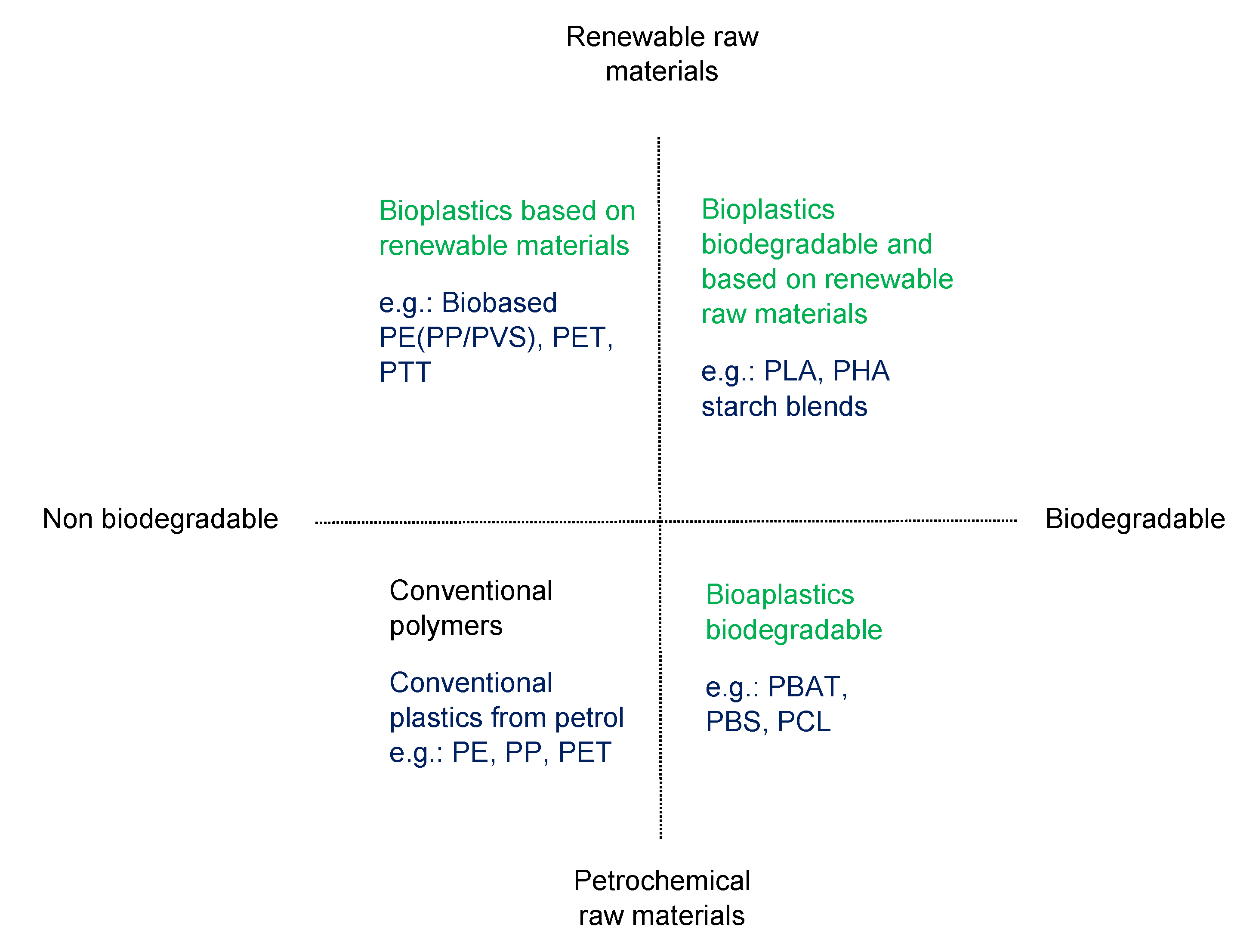

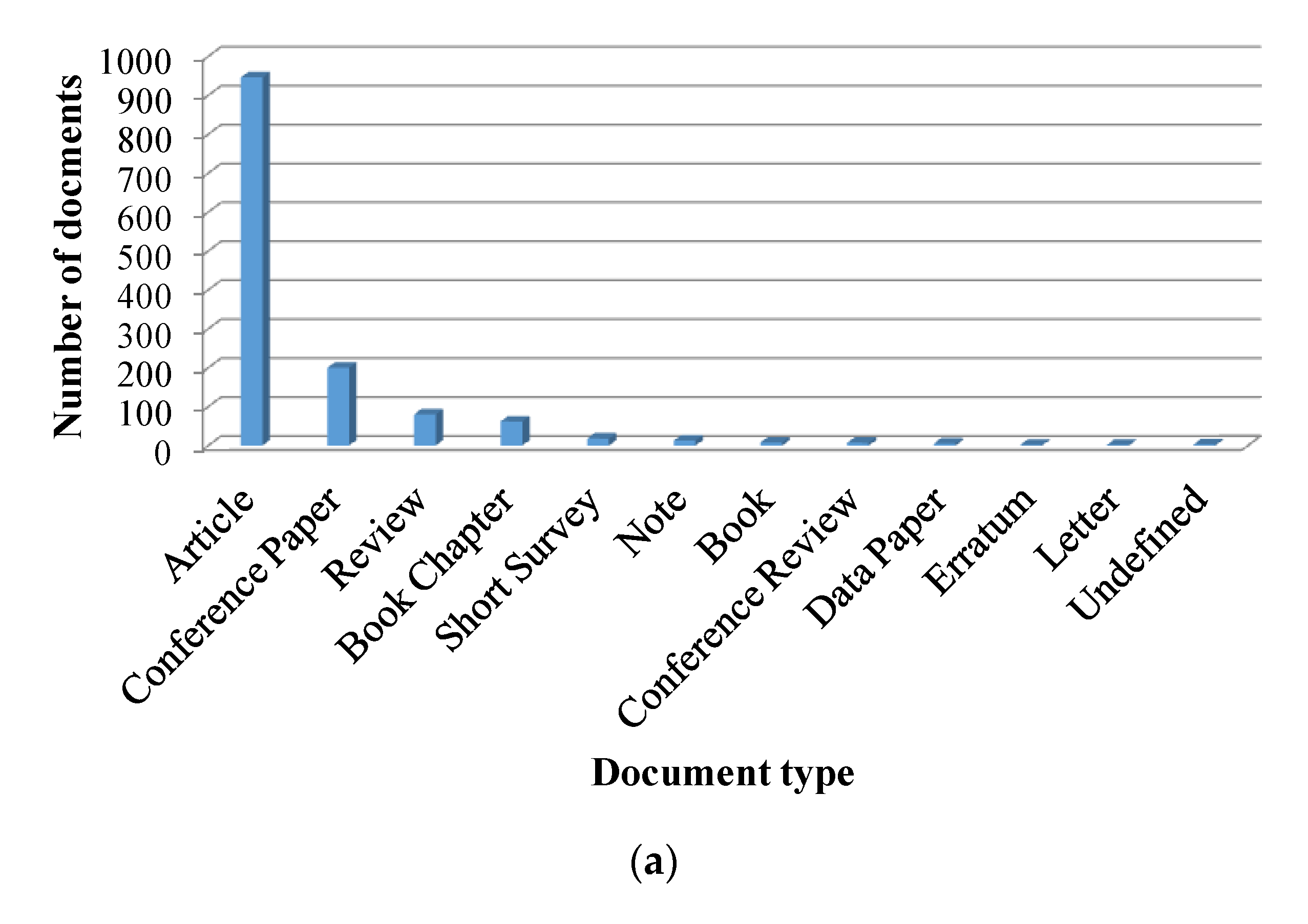
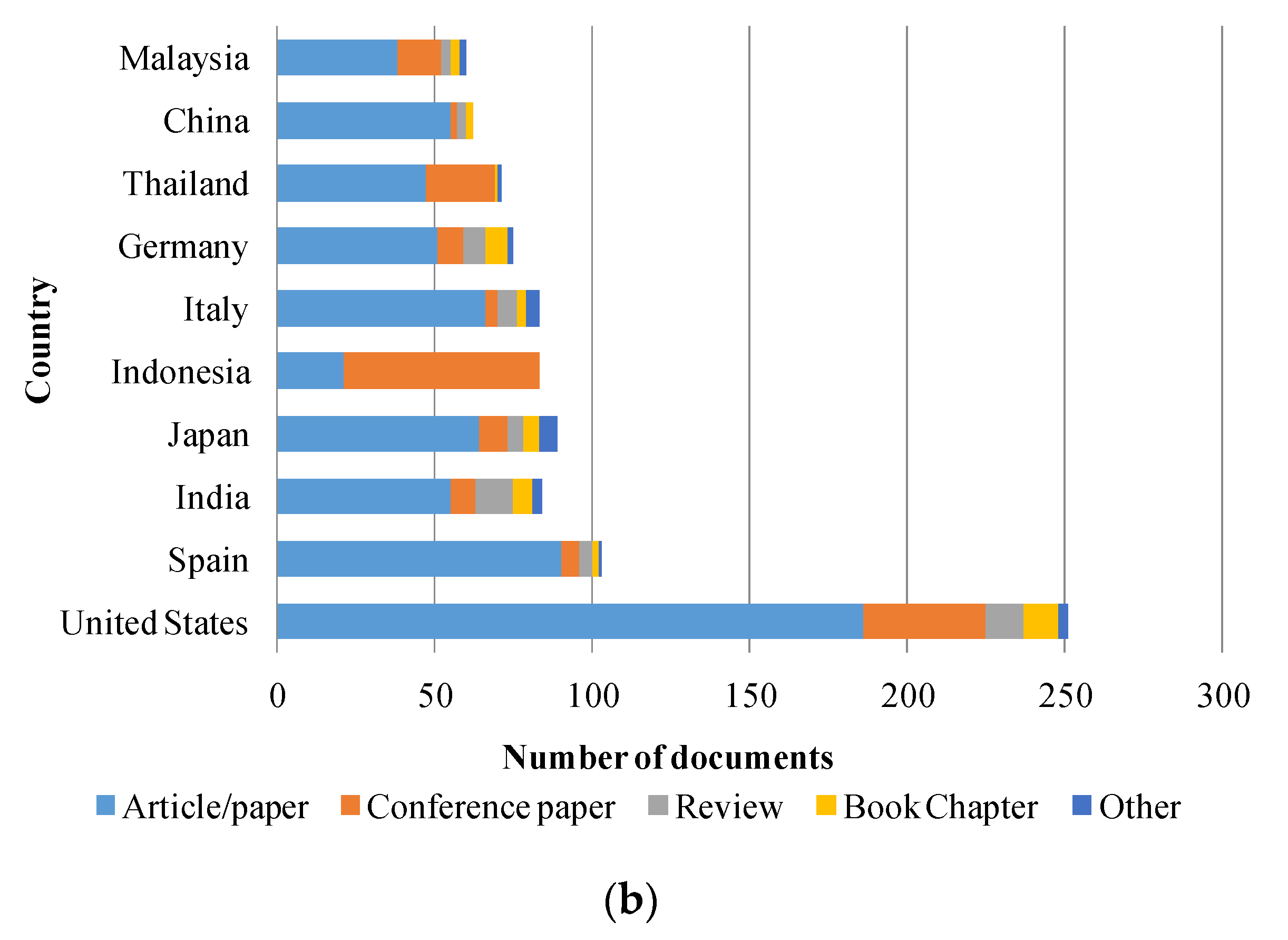
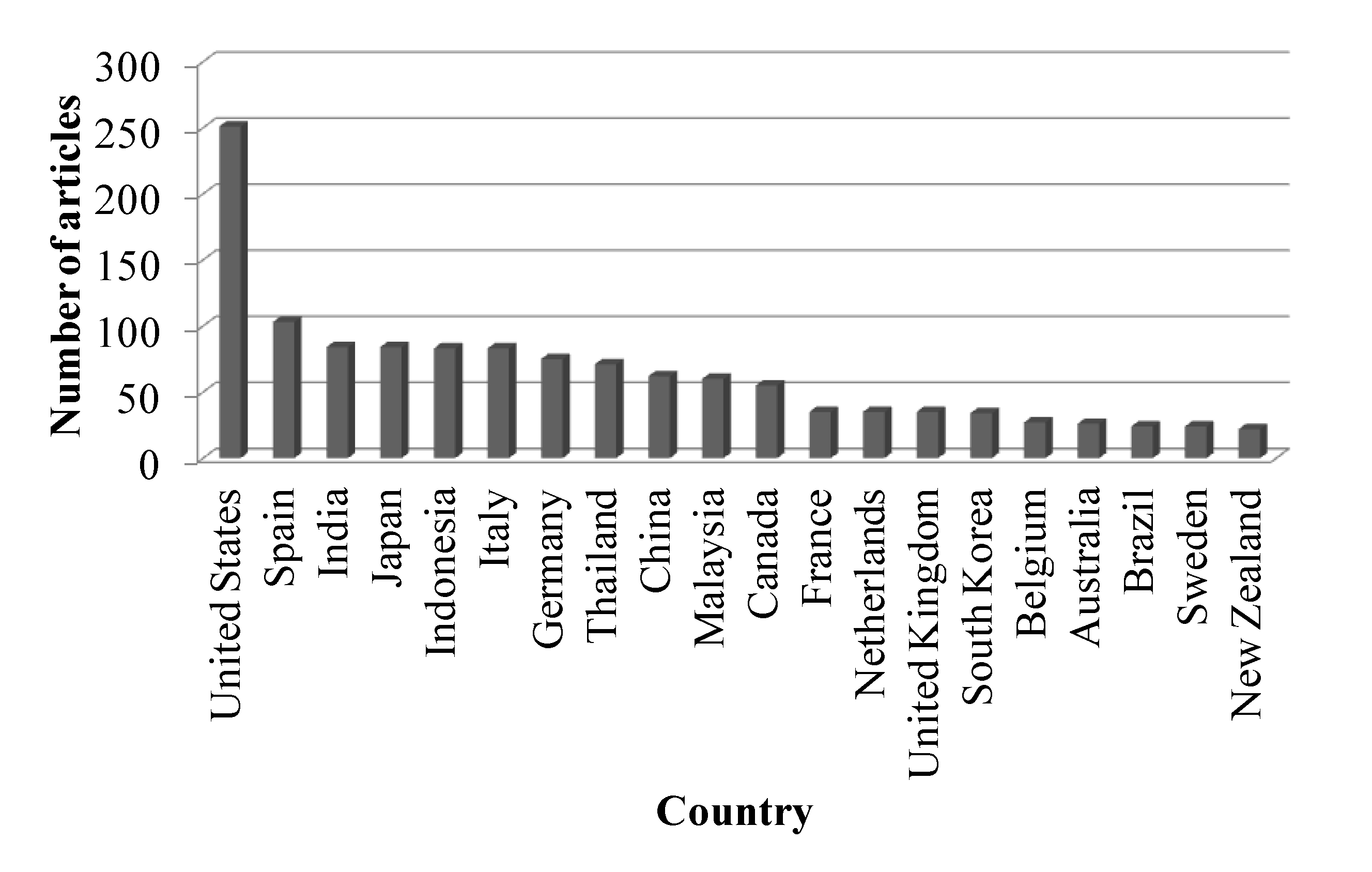

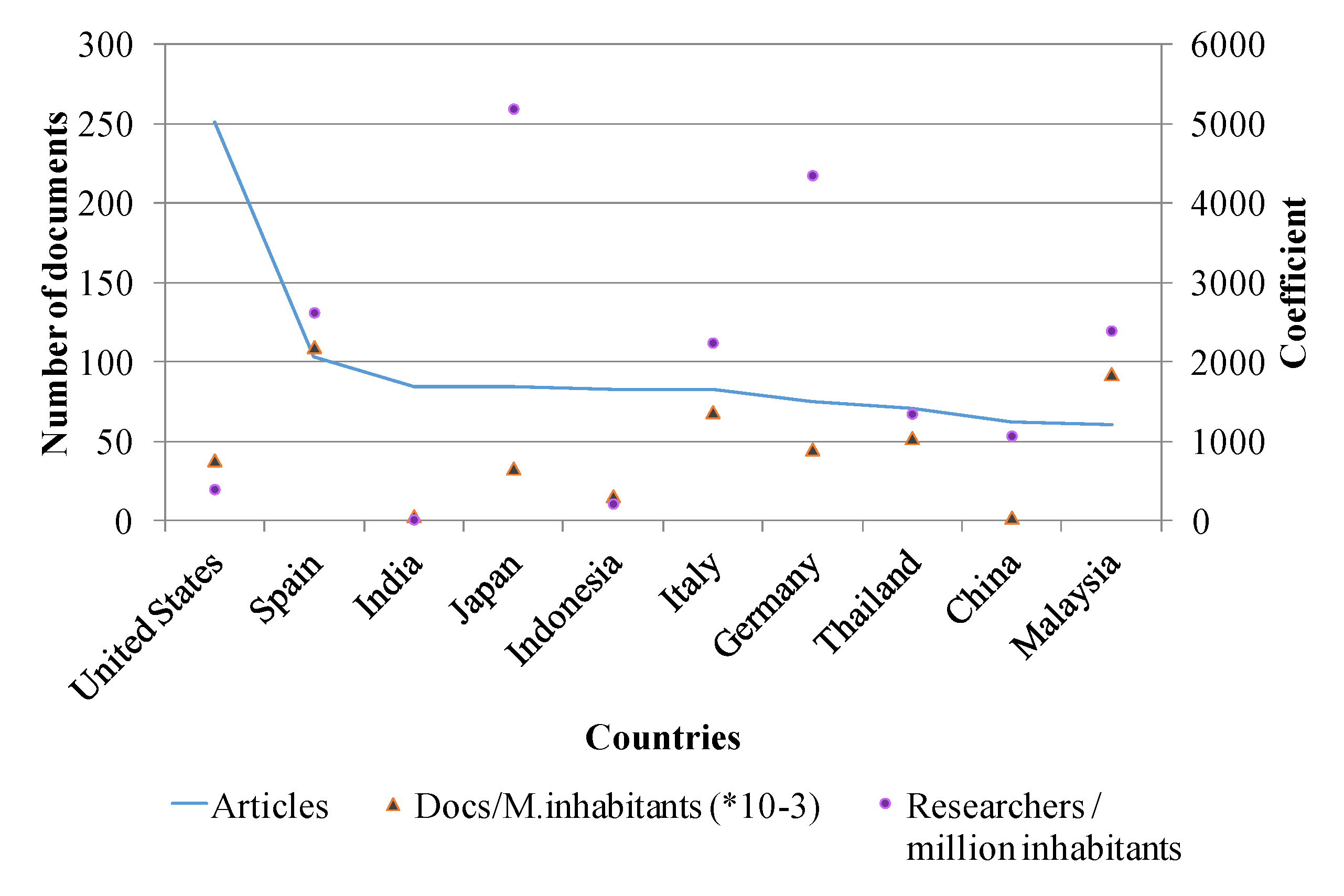
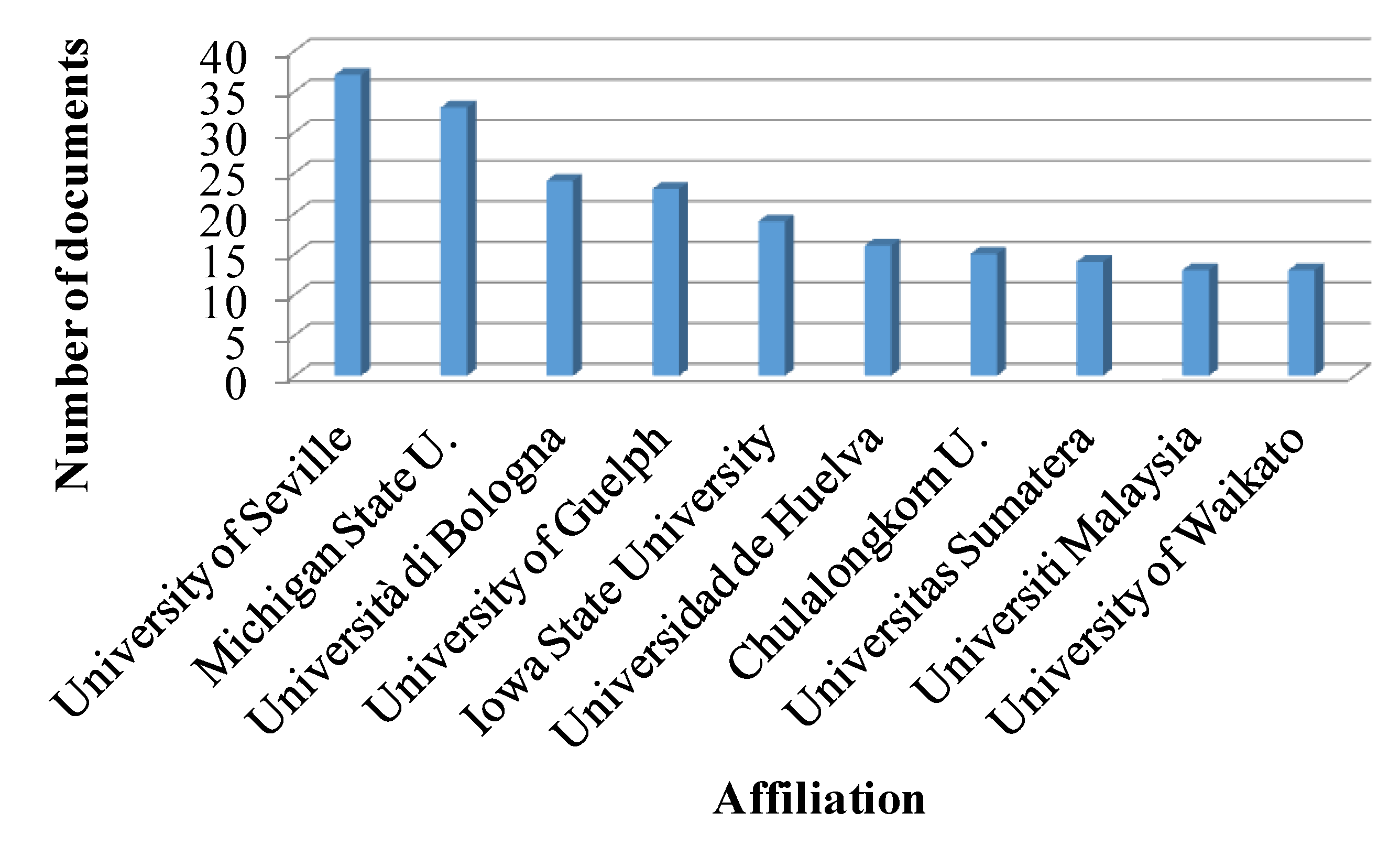
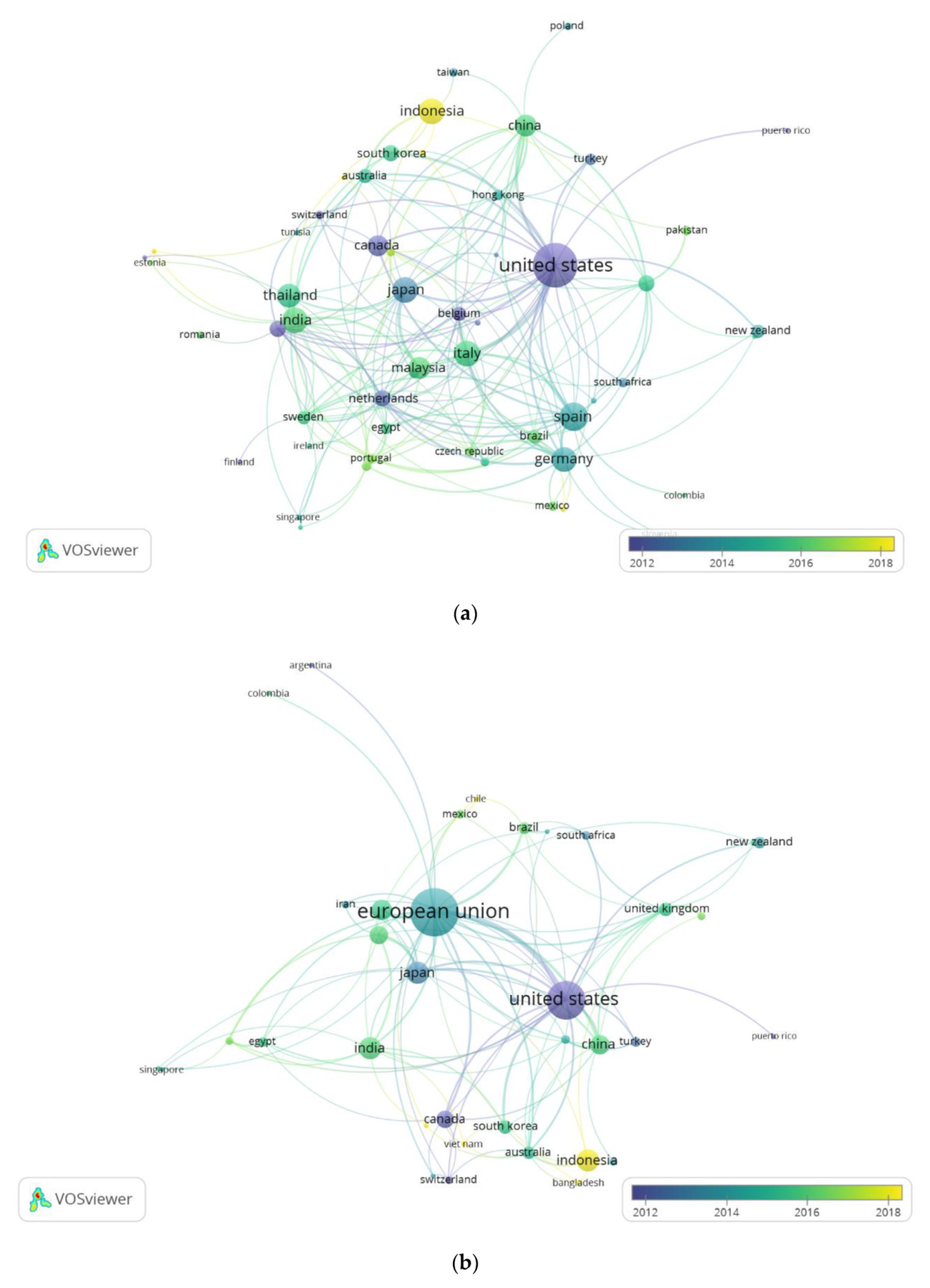
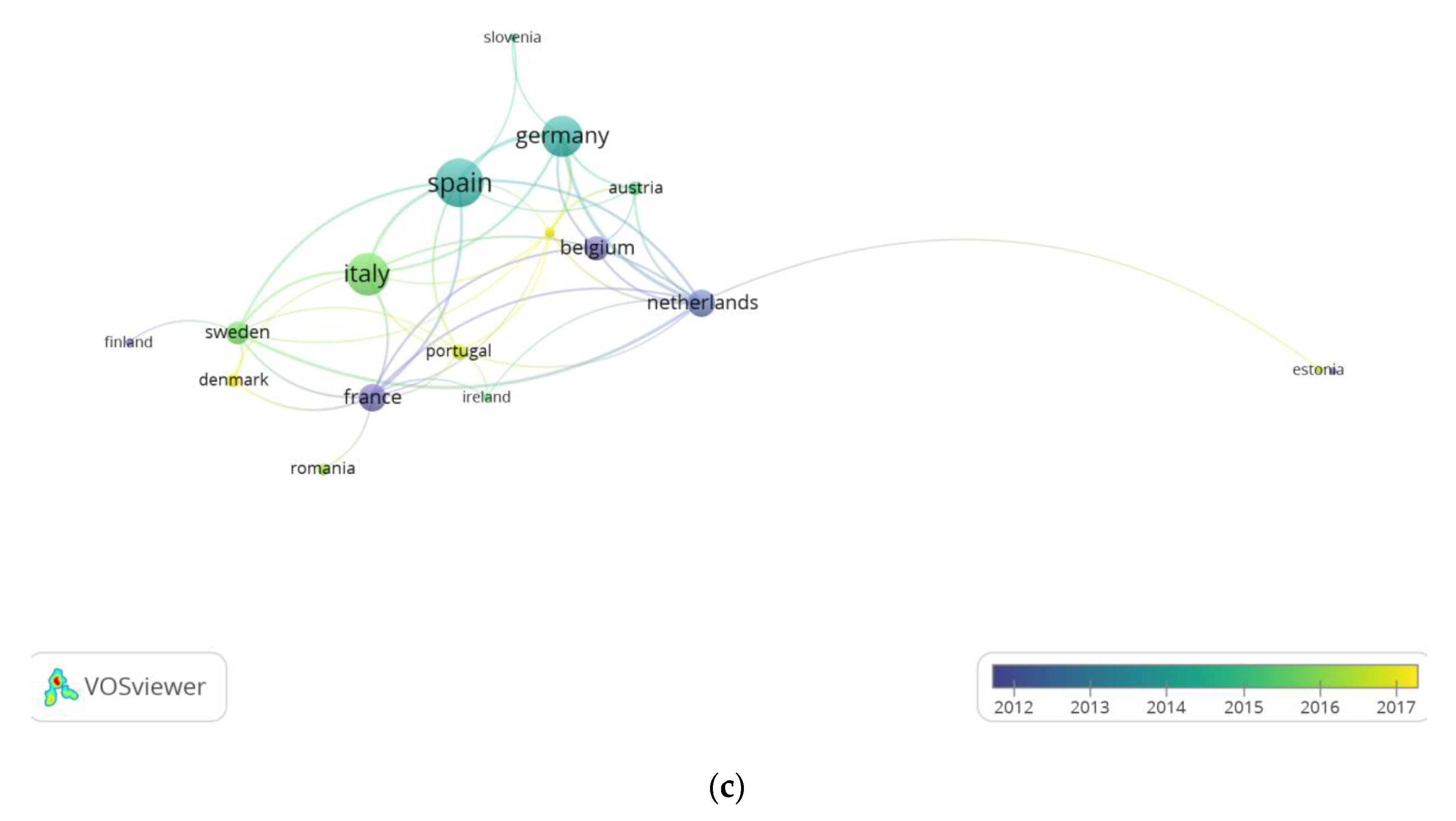
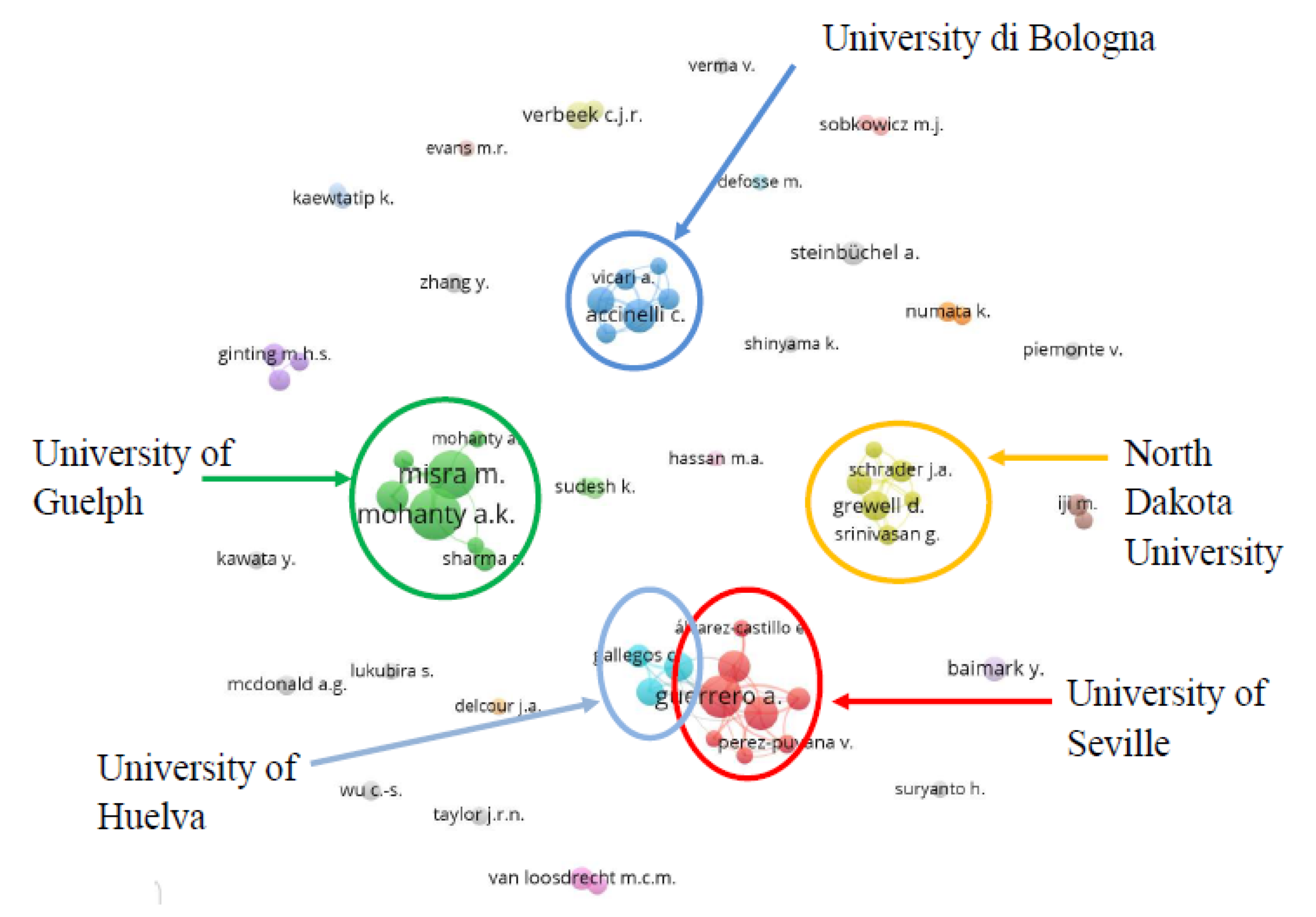
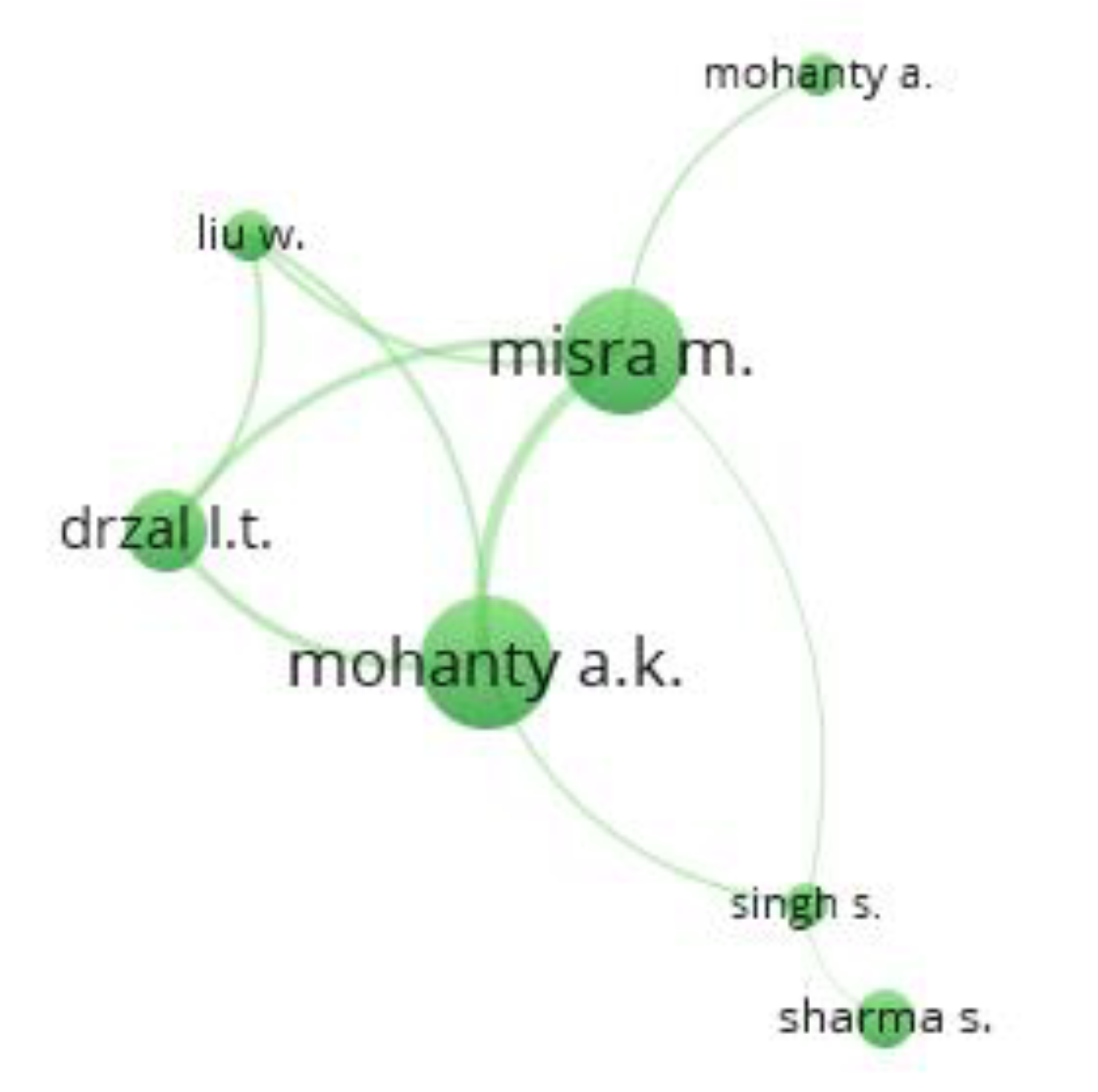
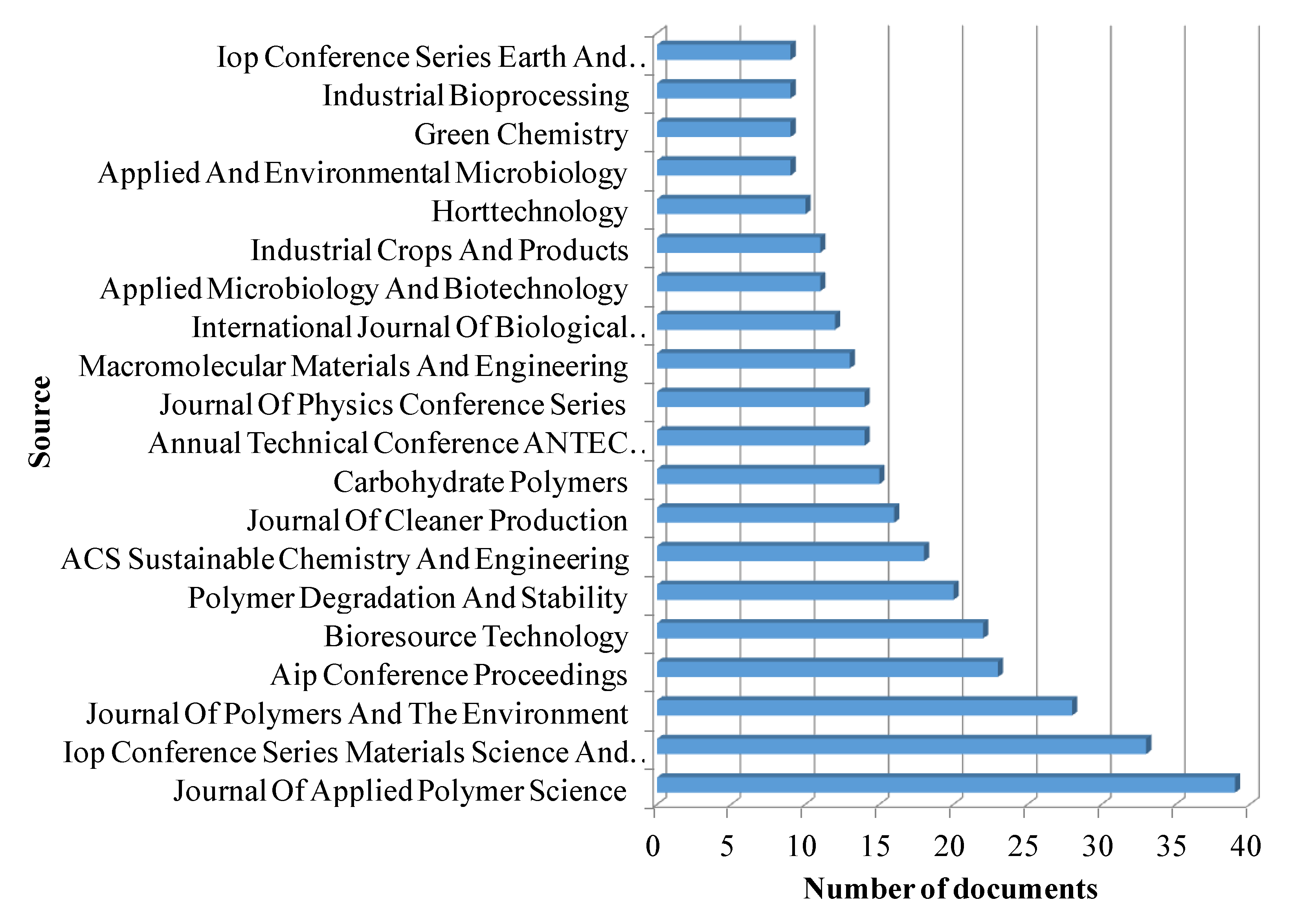
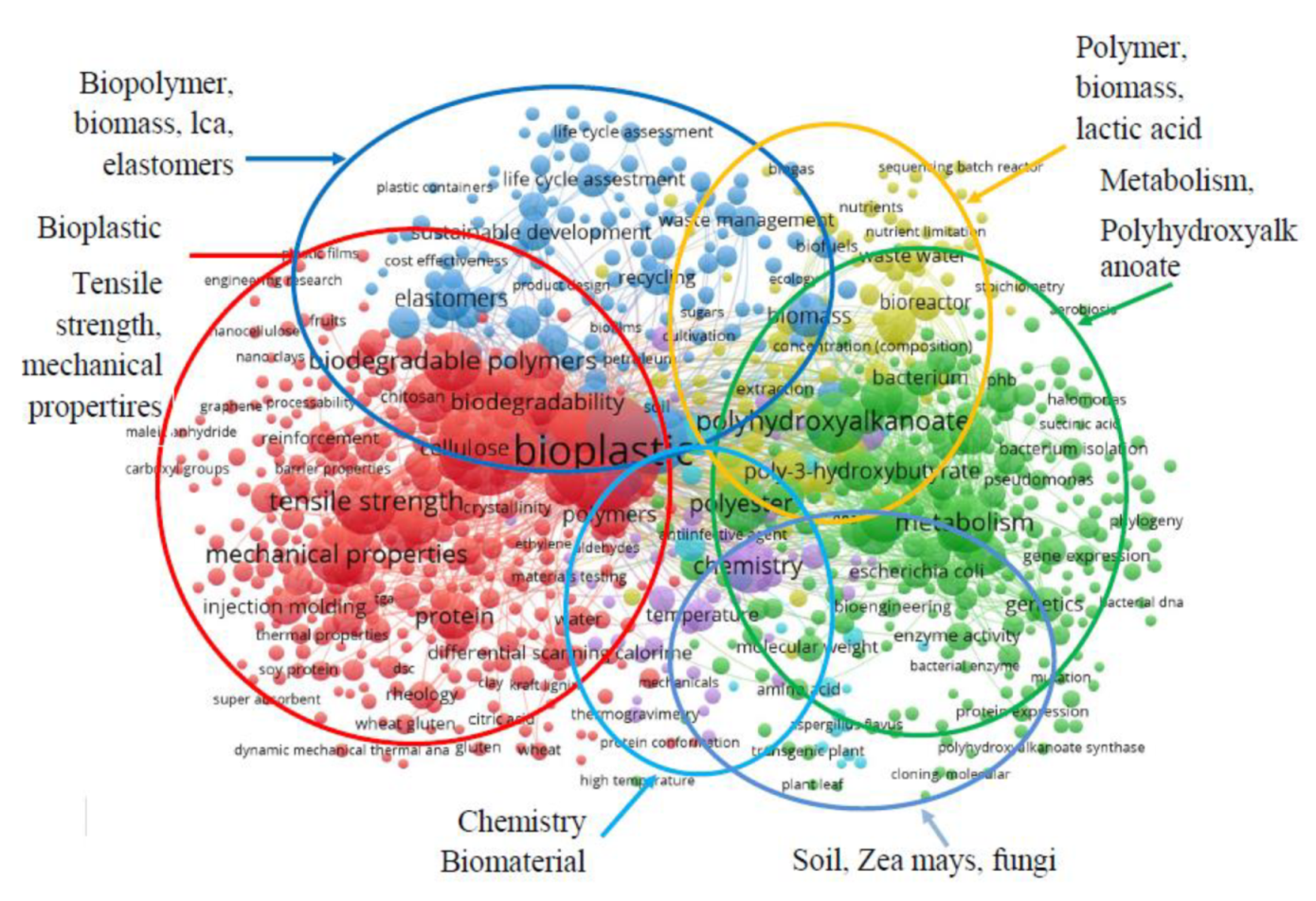
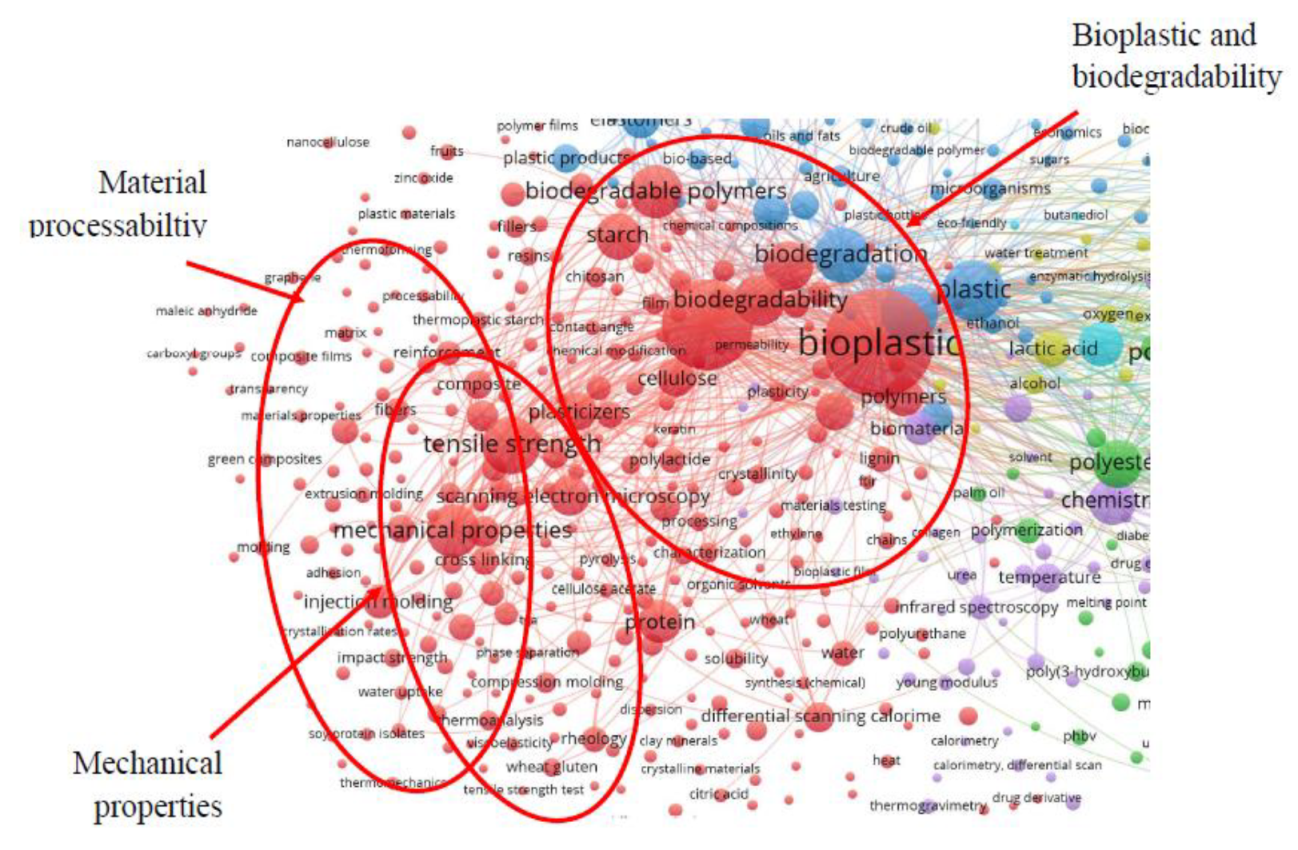
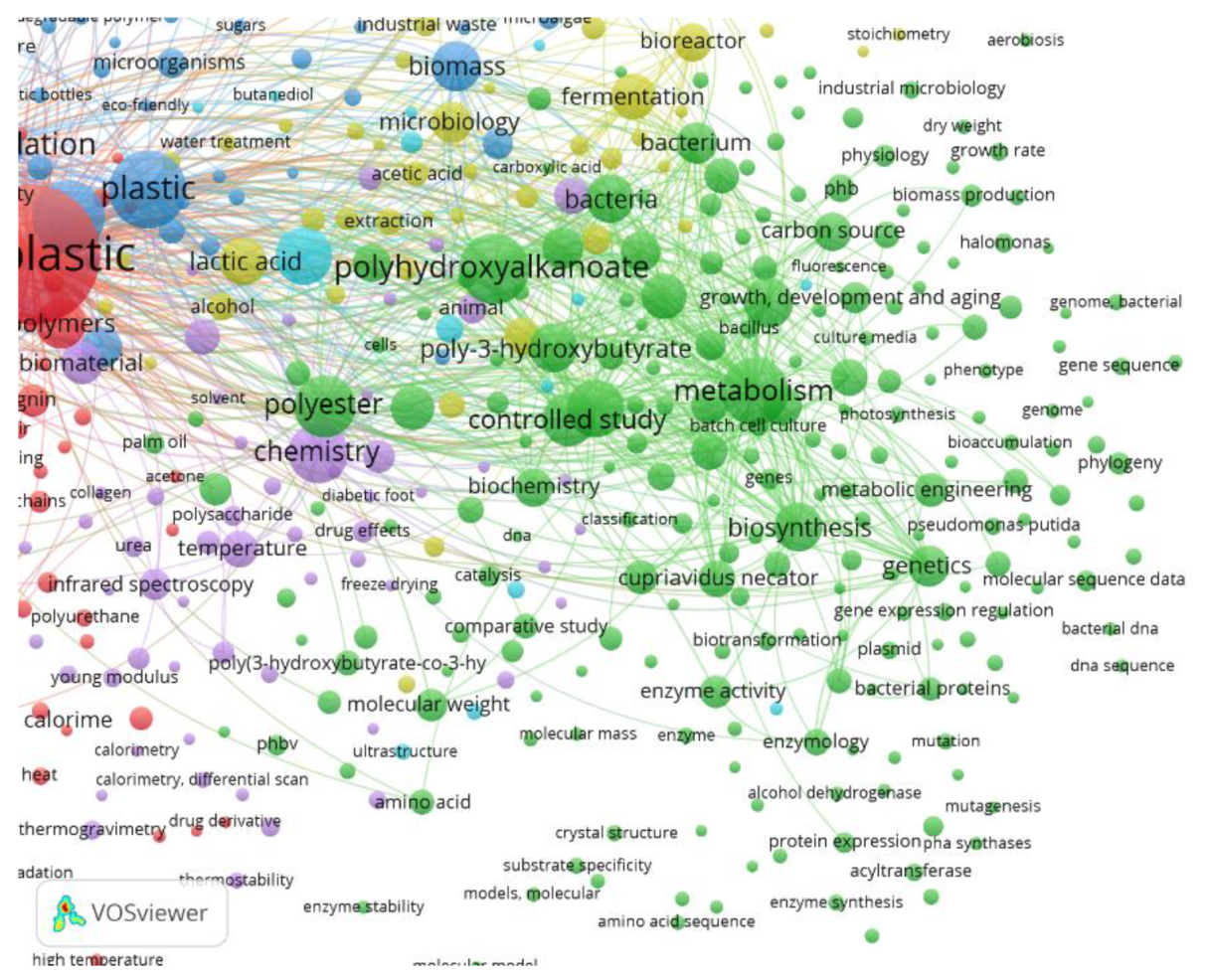
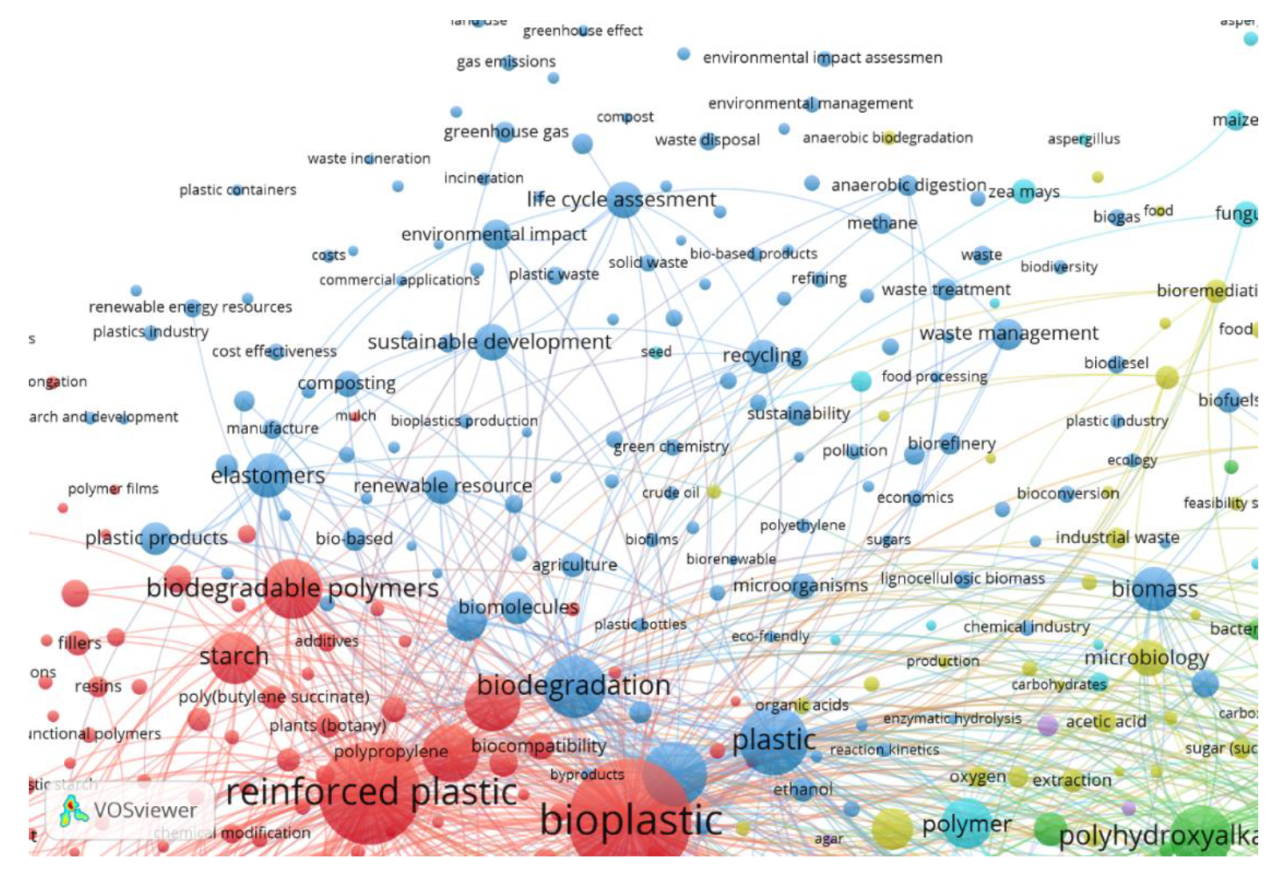
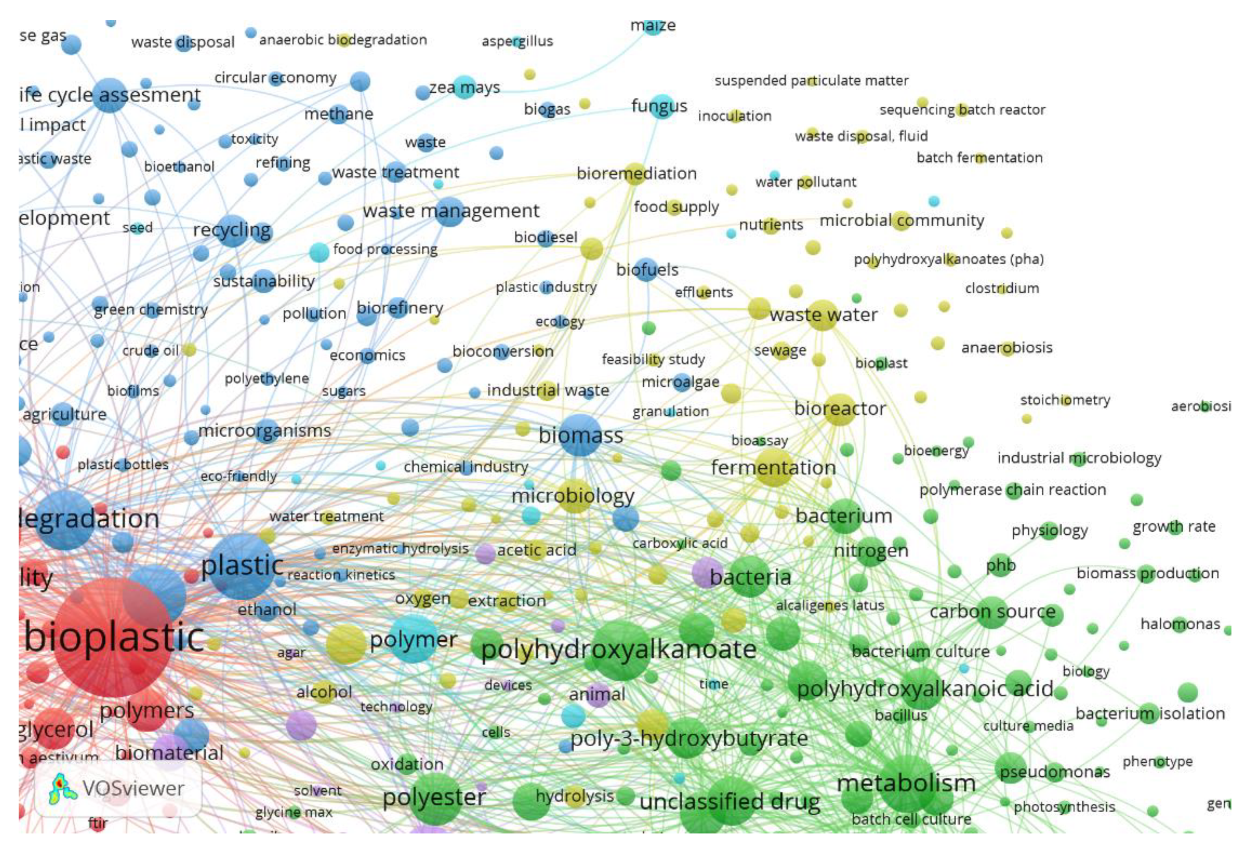
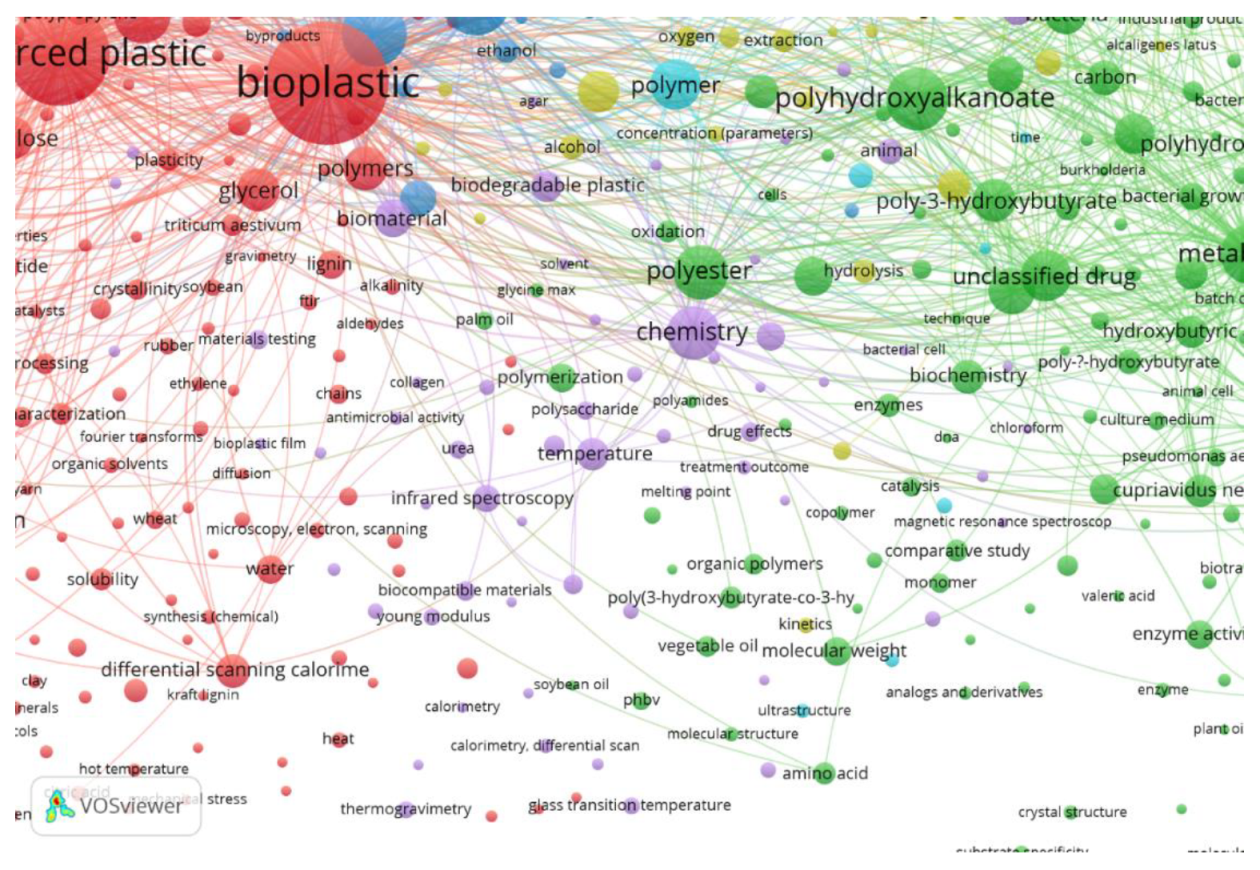
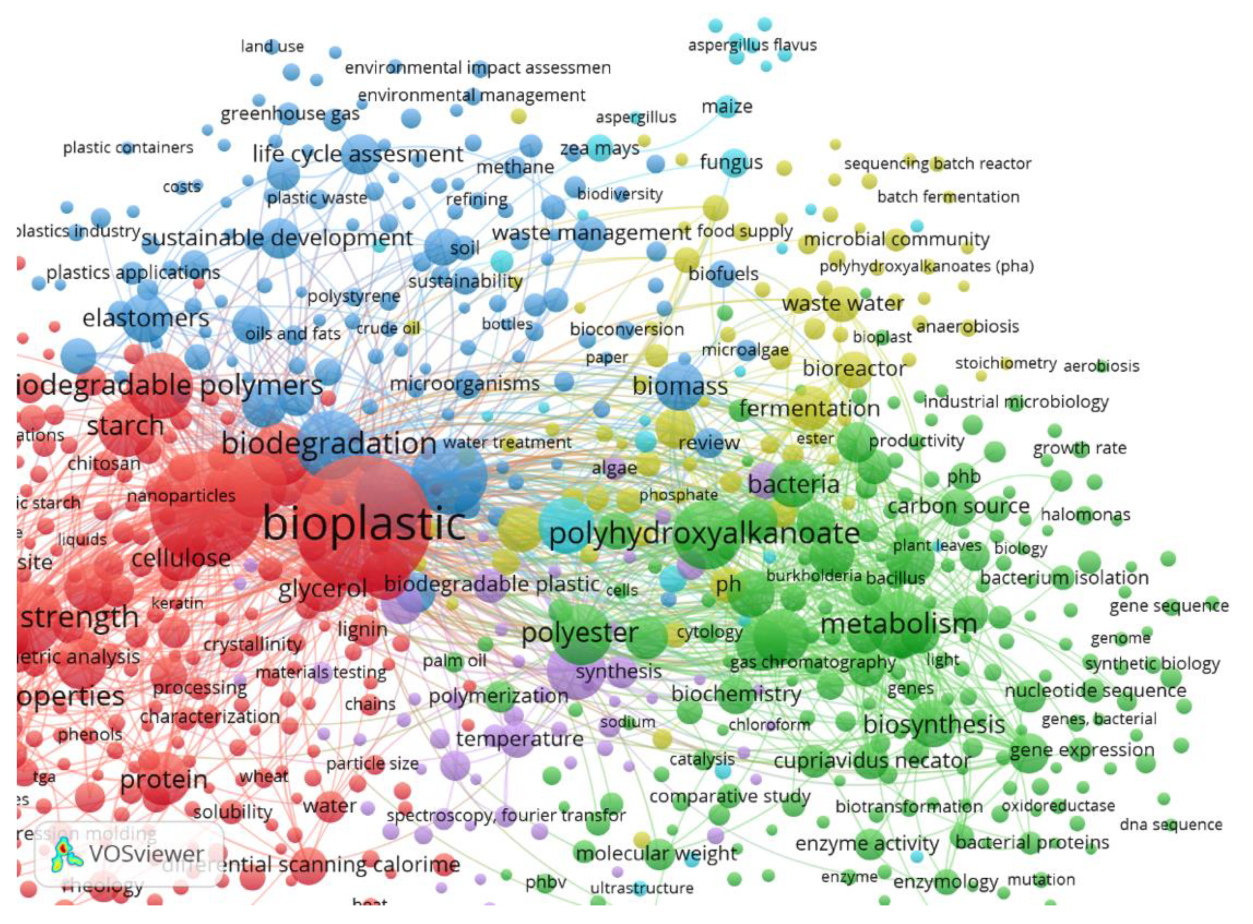
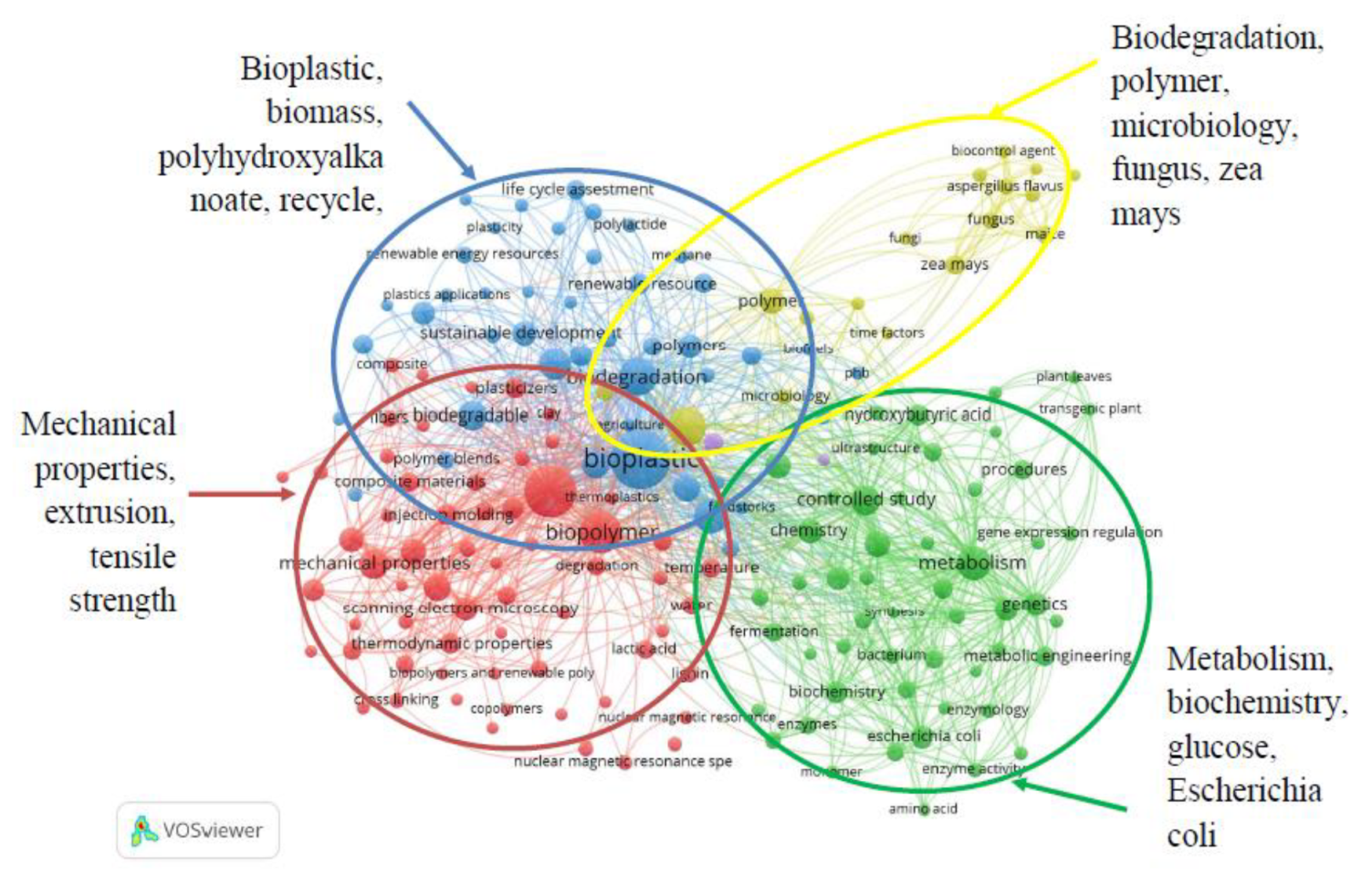
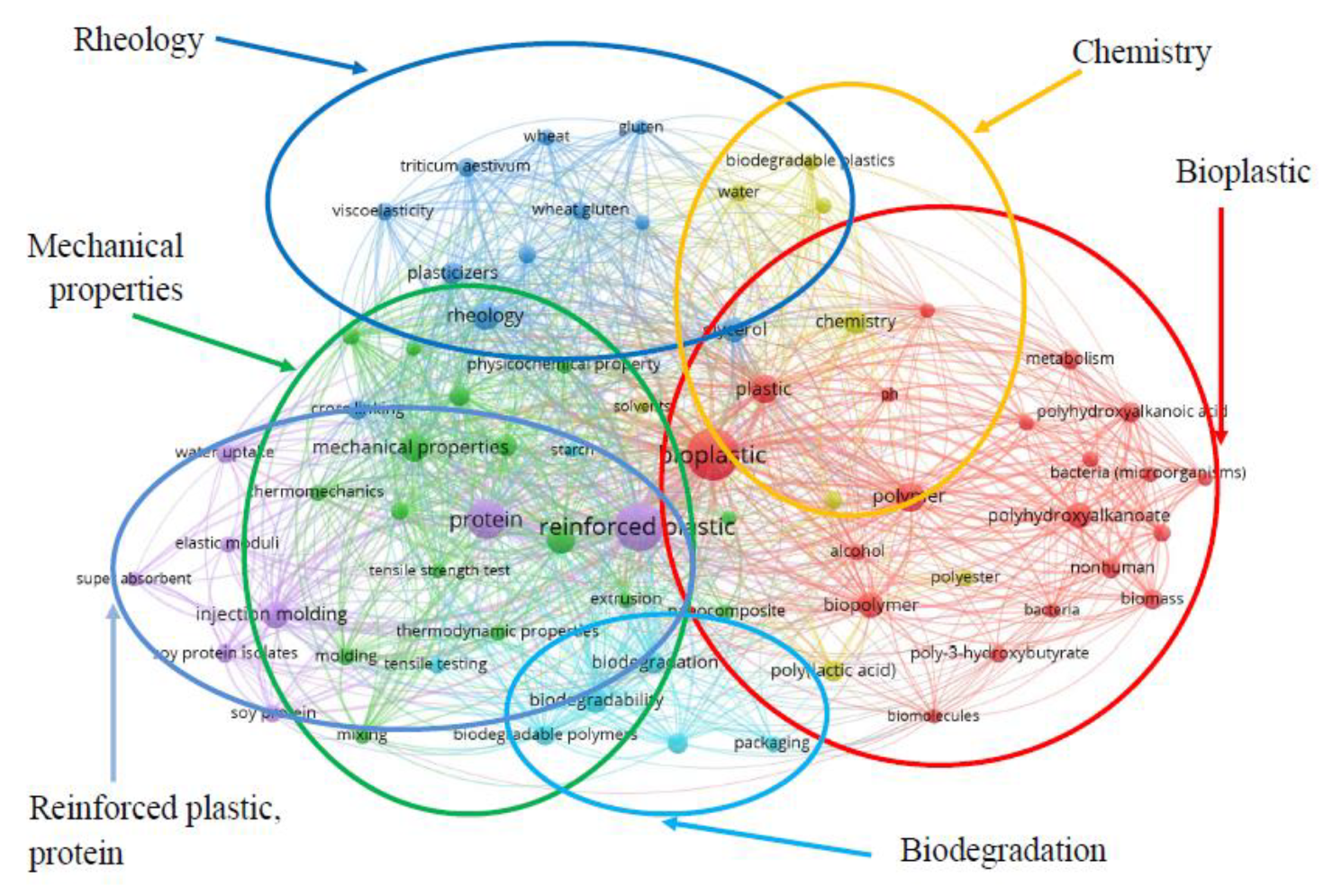
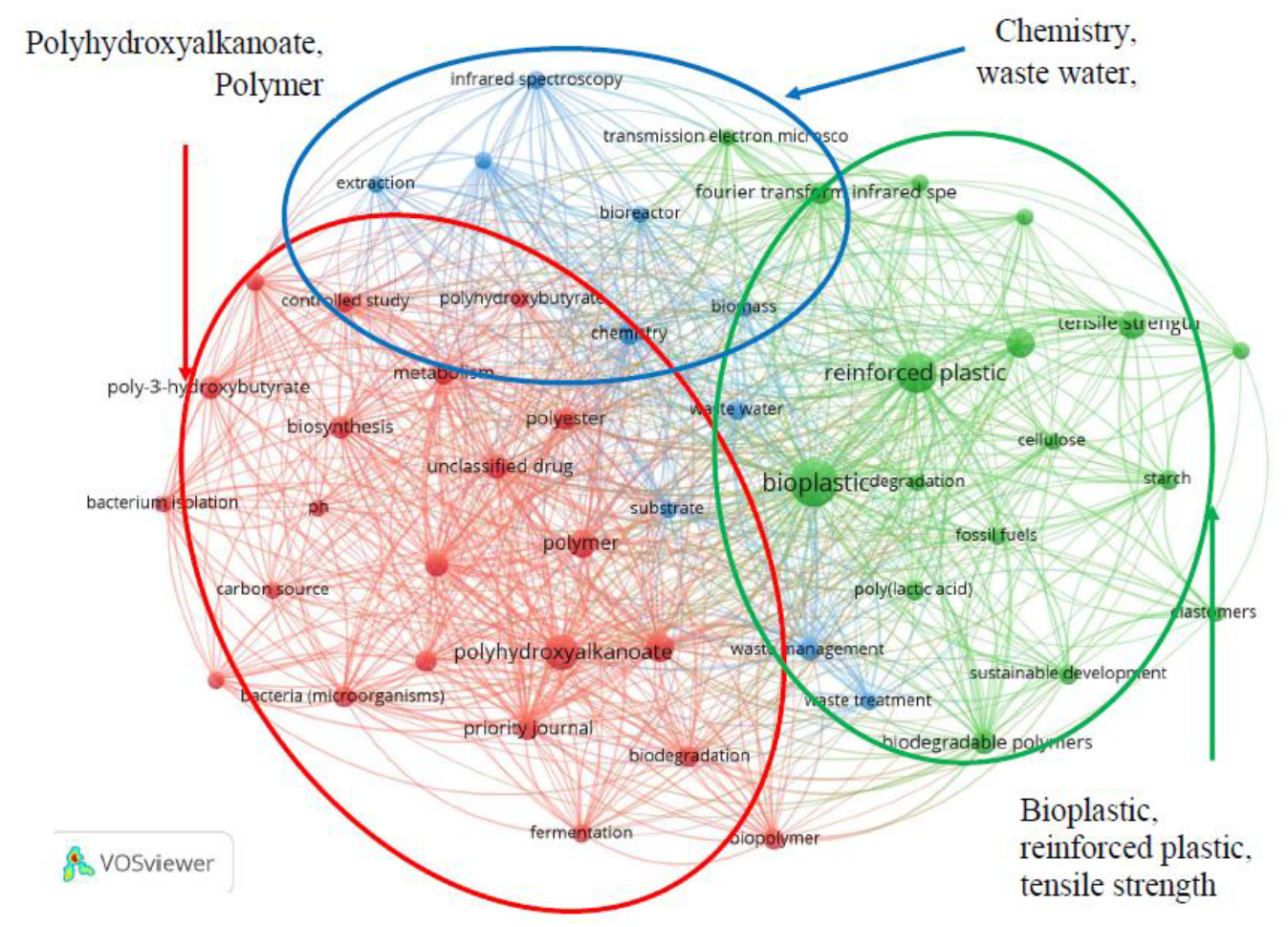
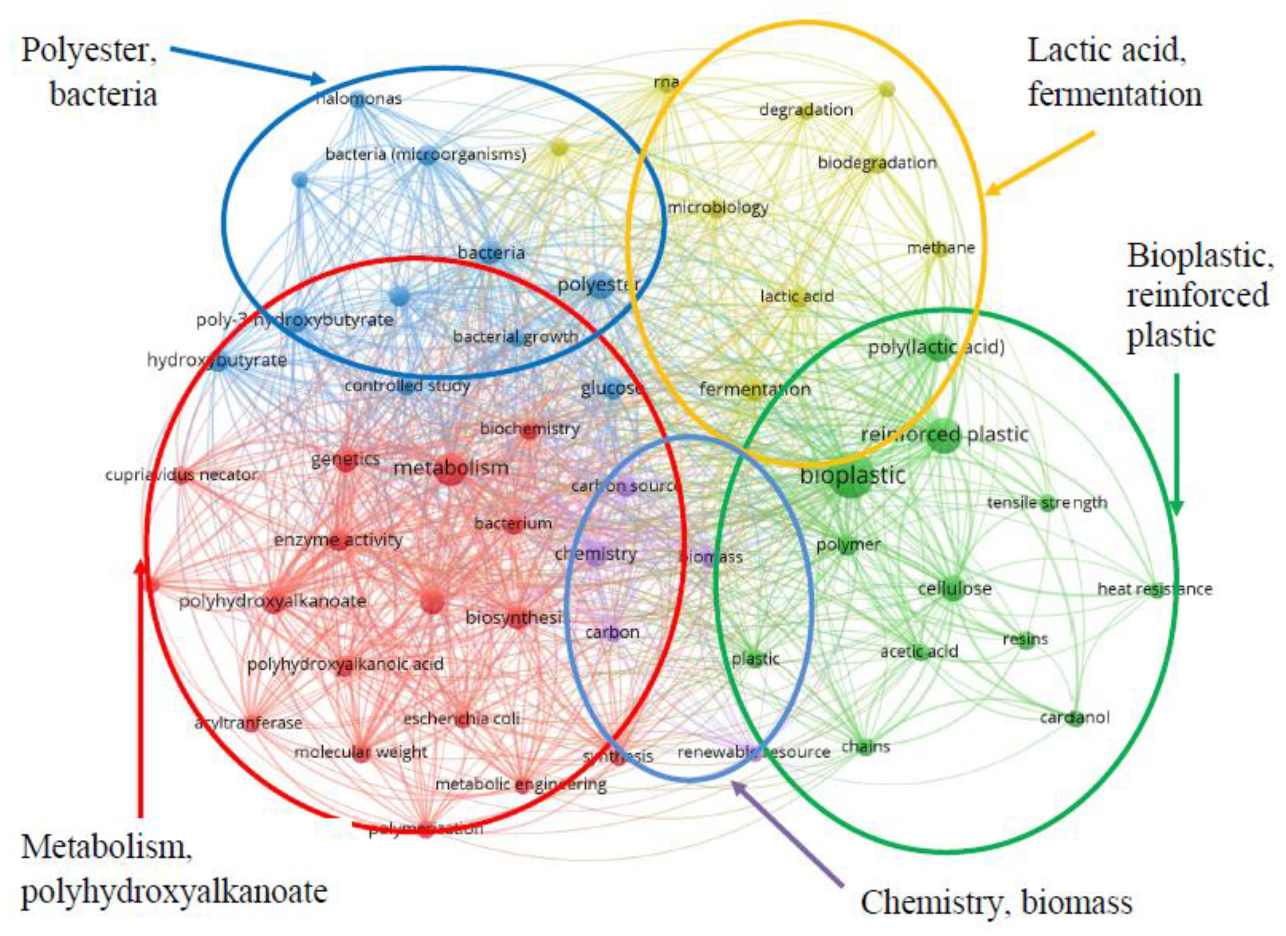
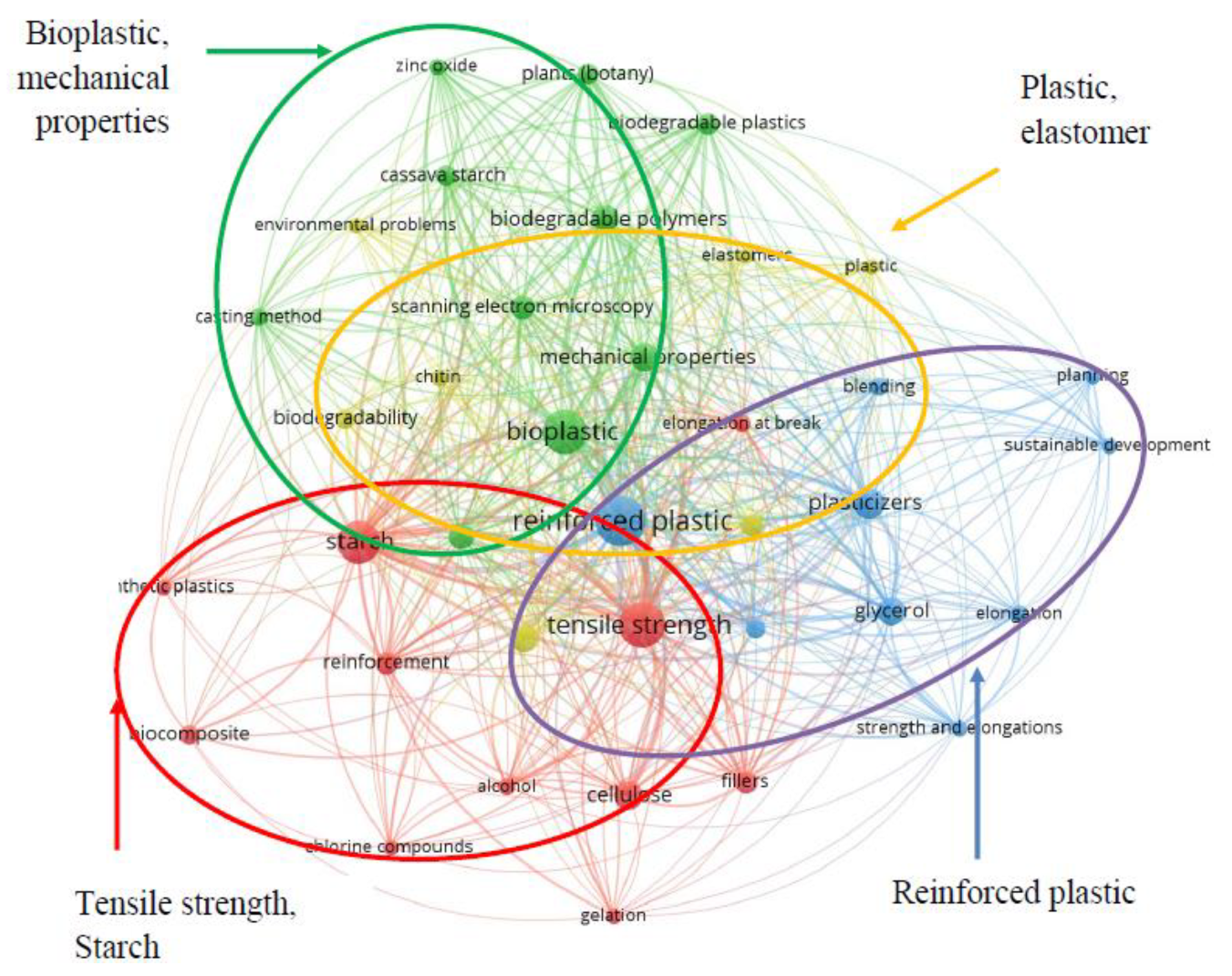
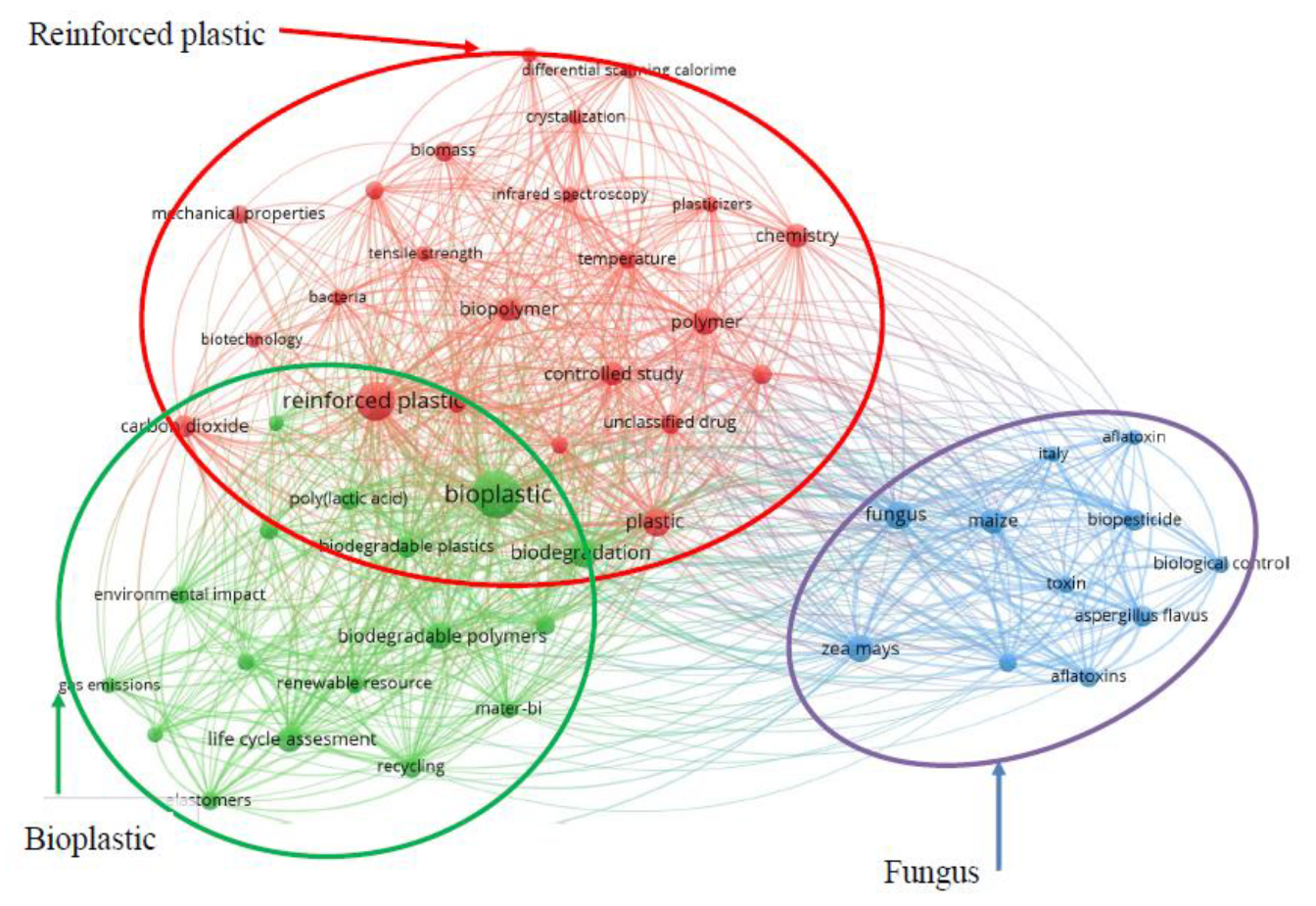
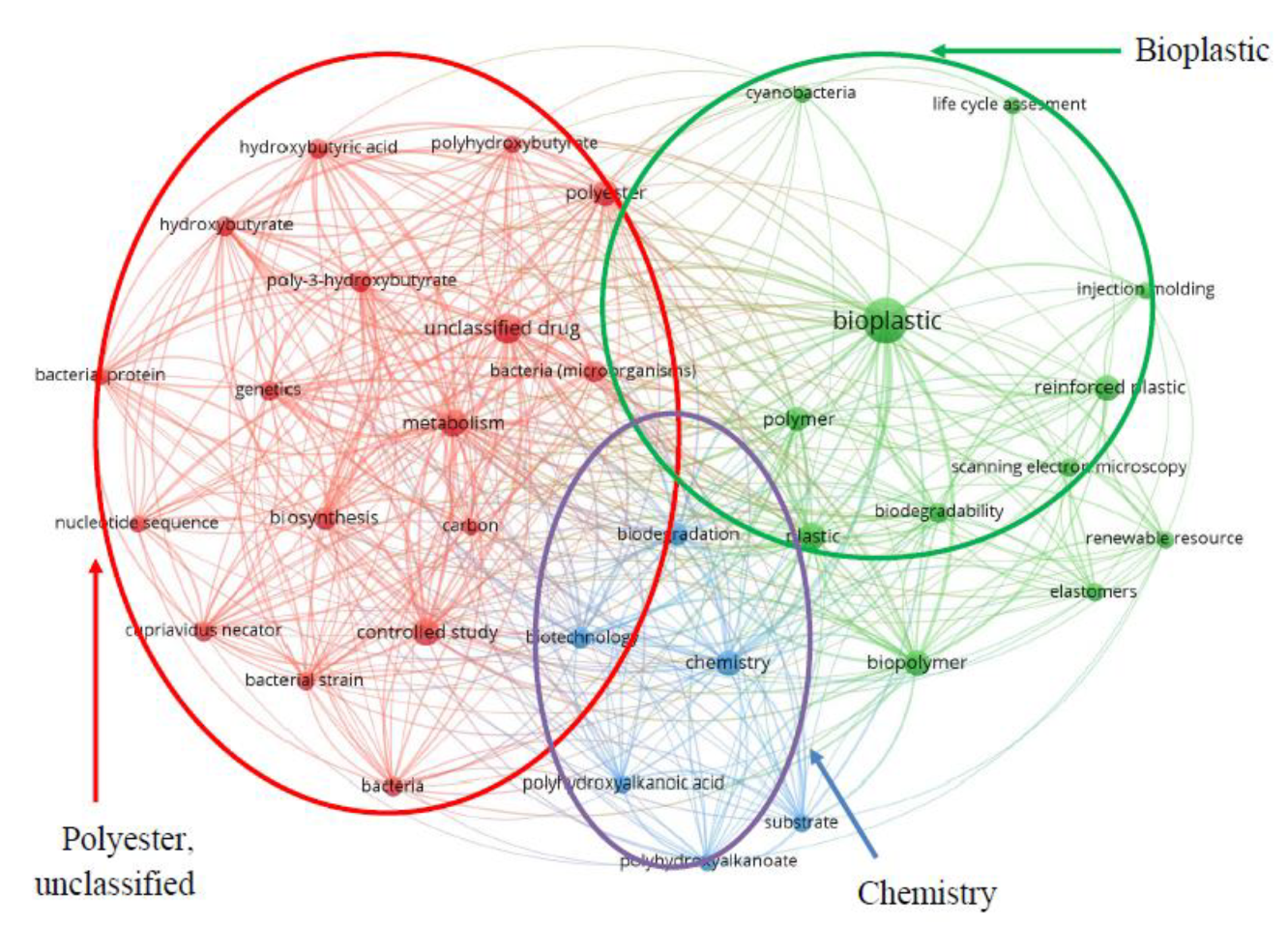
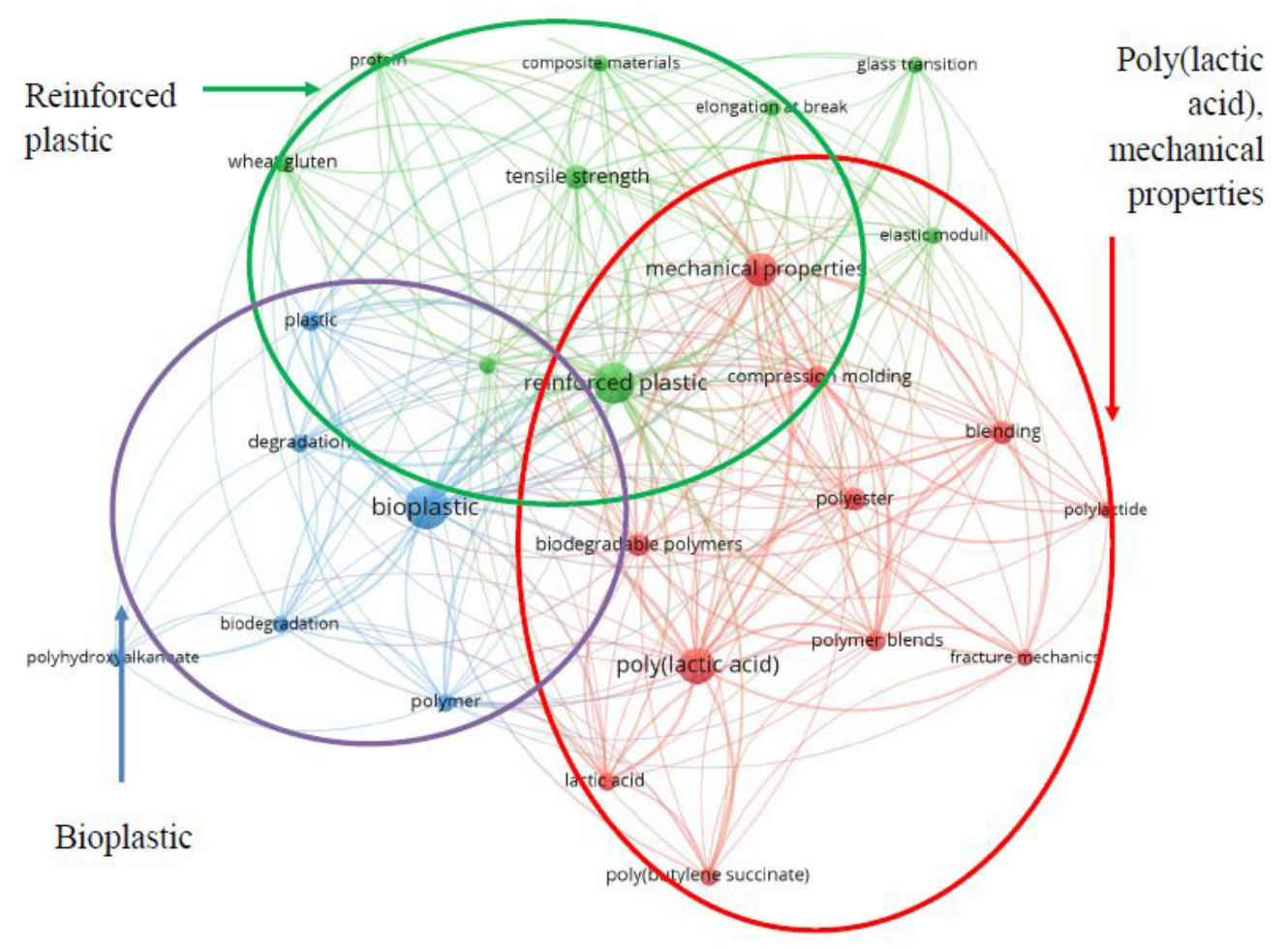
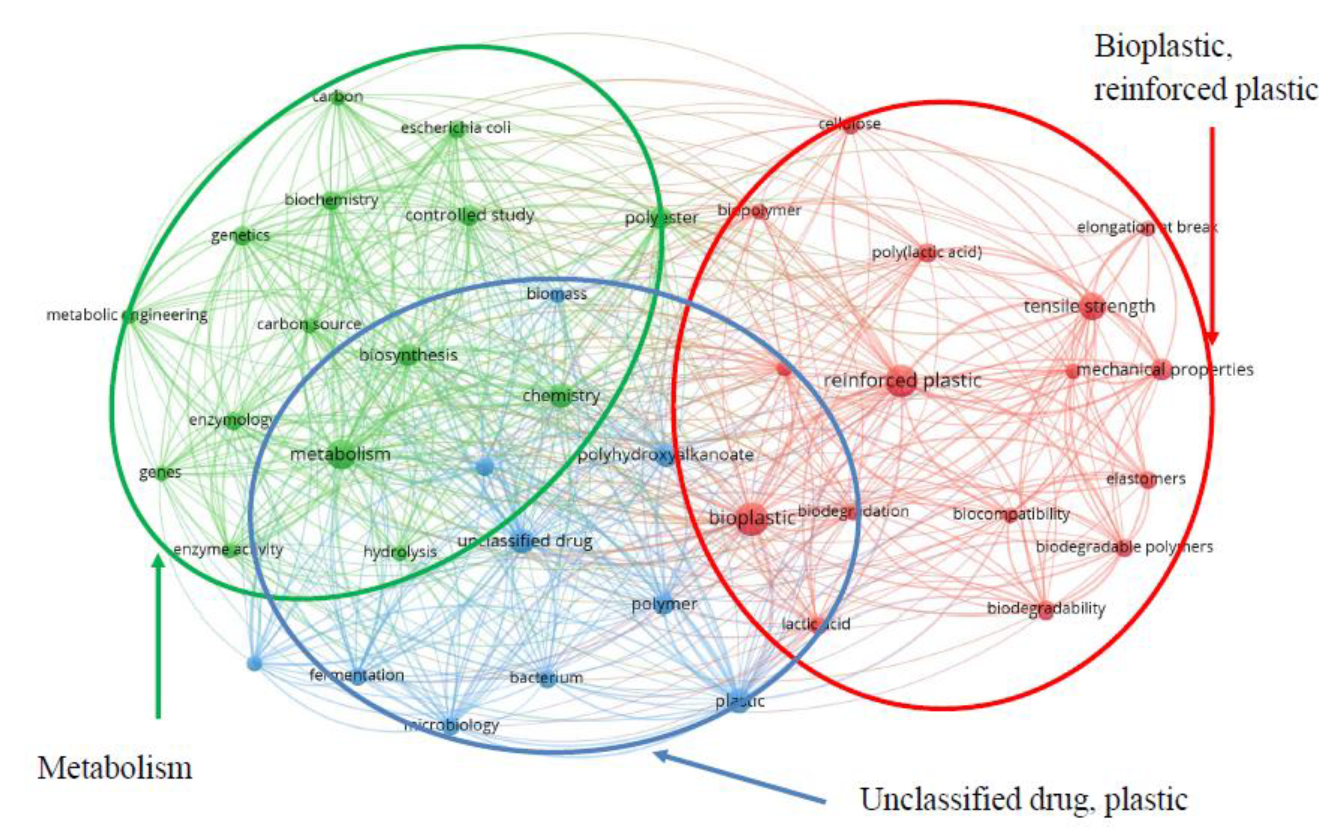
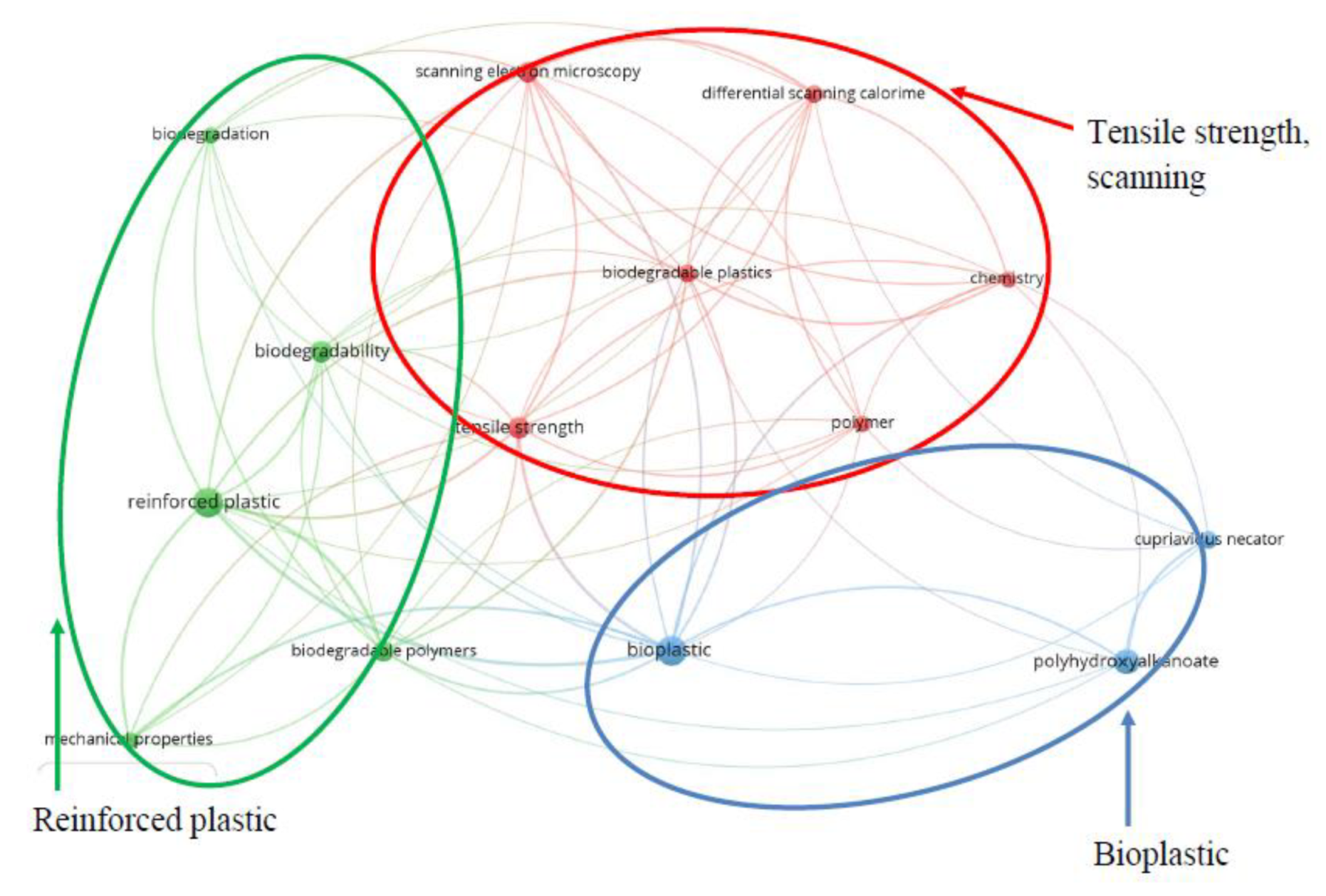
| Country | Million Inhabitants | Articles | Docs/M.Inhabitants | GDP 2019, $ | Art./Th. GDP | Researchers/ Million Inhabitants |
|---|---|---|---|---|---|---|
| United States | 327.35 | 251 | 0.767 | 56,844.31 | 4.42 | 398.44 |
| Spain | 46.93 | 103 | 2.195 | 36,311.32 | 2.84 | 2626.00 |
| India | 1352.62 | 84 | 0.062 | 7314.57 | 11.48 | 15.99 |
| Japan | 126.53 | 84 | 0.664 | 39,763.14 | 2.11 | 5194.80 |
| Indonesia | 264.16 | 83 | 0.314 | 12,220.82 | 6.79 | 216.00 |
| Italy | 60.36 | 83 | 1.375 | 35,331.75 | 2.35 | 2245.00 |
| Germany | 83.02 | 75 | 0.903 | 46,765.48 | 1.60 | 4355.40 |
| Thailand | 67.79 | 71 | 1.047 | 17,778.84 | 3.99 | 1350.00 |
| China | 1395.38 | 62 | 0.044 | 17,027.48 | 3.64 | 1071.10 |
| Malaysia | 32.39 | 60 | 1.853 | 28,705.92 | 2.09 | 2397.00 |
| Author Name | Number | Country | Institution |
|---|---|---|---|
| Misra, M. | 39 | Canada | University of Guelph |
| Mohanty, A.K. | 33 | Canada | University of Guelph |
| Guerrero, A. | 30 | Spain | University of Seville |
| Accinelli, C. | 18 | Italy | Università di Bologna |
| Romero, A. | 18 | Spain | University of Seville |
| Bengoechea, C. | 16 | Spain | University of Seville |
| Drzal, L.T. | 16 | United States | Michigan State University |
| Grewell, D. | 14 | United States | North Dakota State University |
| Partal, P. | 14 | Spain | University of Huelva |
| Martínez, I. | 13 | Spain | University of Huelva |
| Country | Bioplastic | Reinforced Plastic | Tensile Strength | Biodegradation | Plastic | Biodegradable Polymers | Metabolism | Mechanical Properties | Biopolymers | |
|---|---|---|---|---|---|---|---|---|---|---|
| Keyword | ||||||||||
| United States | 1 | 2 | 21 | 6 | 3 | 13 | 5 | 16 | 4 | |
| Spain | 1 | 2 | 7 | 18 | 4 | 25 | 24 | 6 | 10 | |
| India | 1 | 2 | 7 | 17 | 3 | 8 | 12 | -- | 19 | |
| Japan | 1 | 2 | 32 | 29 | 34 | -- | 3 | -- | -- | |
| Indonesia | 3 | 1 | 2 | 20 | 31 | 9 | -- | 8 | -- | |
| Italy | 1 | 2 | 52 | 3 | 5 | 6 | -- | 31 | 11 | |
| Germany | 1 | 7 | 13 | 5 | -- | 3 | -- | 6 | ||
| Thailand | 1 | 2 | 5 | 17 | 10 | 8 | -- | 4 | 25 | |
| China | 1 | 2 | 4 | 29 | 6 | 25 | 3 | 11 | 31 | |
| Malaysia | 1 | 2 | 4 | -- | -- | 6 | -- | 12 | -- | |
Publisher’s Note: MDPI stays neutral with regard to jurisdictional claims in published maps and institutional affiliations. |
© 2021 by the authors. Licensee MDPI, Basel, Switzerland. This article is an open access article distributed under the terms and conditions of the Creative Commons Attribution (CC BY) license (https://creativecommons.org/licenses/by/4.0/).
Share and Cite
Garrido, R.; Cabeza, L.F.; Falguera, V. An Overview of Bioplastic Research on Its Relation to National Policies. Sustainability 2021, 13, 7848. https://doi.org/10.3390/su13147848
Garrido R, Cabeza LF, Falguera V. An Overview of Bioplastic Research on Its Relation to National Policies. Sustainability. 2021; 13(14):7848. https://doi.org/10.3390/su13147848
Chicago/Turabian StyleGarrido, Ricard, Luisa F. Cabeza, and Victor Falguera. 2021. "An Overview of Bioplastic Research on Its Relation to National Policies" Sustainability 13, no. 14: 7848. https://doi.org/10.3390/su13147848
APA StyleGarrido, R., Cabeza, L. F., & Falguera, V. (2021). An Overview of Bioplastic Research on Its Relation to National Policies. Sustainability, 13(14), 7848. https://doi.org/10.3390/su13147848








